Search Results
Filter by Topic
How to Prepare & Submit the Form I-693
How to Prepare & Submit the Form I-693
USCIS Forms
How to fill out Form I-693 (For the Applicant)
The I-693 includes 10 parts. As the Applicant you only need to fill out Part 1 before your doctor appointment. You will also need to write your name and Alien Number (when you have one) at the top of each page of the form. This should be an 8 or 9 digit number starting with the letter A and can be found on any letters or notices you may have received from the Department of Homeland Security.To fill out Part 1 you will need:
- Your full name (your legal name)
- Your address – the place you live, PO boxes will not work
- Your sex
- Your date of birth
- The city, town, or village in which you were born
- The country you were born in
- Your Alien Registration Number (A-Number) if you have one
- Your USCIS online account number, if you have one
As the Applicant you will also need to fill out Part 2. This part is where you give some contact information and sign the form. You MUST fill out this section with the civil surgeon present to witness you filling it out. Form I-693 is included in Green Card Application Builder
Doctor Appointment
To find a USCIS certified surgeon:
- Go to uscis.gov
- Select “Find a Doctor”
- Enter your ZIP Code
- Click “Search"
A list of doctors in your area should appear. Select one and make an appointment by calling the number next to it.
How to fill out Form I-693 (For the Interpreter
You will be required to fill out Part 3. This includes:
- Your name
- The name and address of the business or organization (when applicable)
- Your daytime telephone number
- Your mobile telephone number (if you have one)
- Your email address (if you have one)
- Your signature and the date
How to fill out Form I-693 (For the Civil Surgeon)
As a USCIS certified civil surgeon you are required to report true and accurate results from your examination.To do this you will need to take down the information from the Applicant’s government-issued identification. You will also be responsible for witnessing that the Applicant fills out and signs Part 2.You will need to follow the most recent Department of Health and Human Services regulations and the Centers for Disease Control and Prevention guidelines. Those guidelines can be found here.You may also be asked to make referrals and file case reports. These processes can also be found in the CDC guidelines.When filling out the I-693 you will need to:
- Verify the Applicant’s Identification Information
- Give a summary of the medical examination, after the exam and any follow-ups necessary are completed
- Give your contact information and sign the form after the examination is complete, certifying that you are a legal civil surgeon. (If you are performing the assessment for a refugee adjustment applicant you will need to include the licensed physician that was present during the examination and the official stamp or raised seal of the health department. If you are a military physician performing the examination for a member or veteran of the U.S. Armed Forces or Coast Guard or certain eligible dependents, the licensed military physician’s signature – who is operating under the blanket civil surgeon – is required as well as the official stamp or raised seal of the military treatment facility.)
- Fill out the worksheet included in the I-693
- Include the results of any lab work or other studies that were required to determine whether the Applicant is inadmissible to the U.S. on health-related issue
- If a referral is required, fill out Item 5 in the worksheet found in Part 7. The physician referred will then need to fill out Part 8. (If a referral is not necessary, leave Item 5 in the worksheet blank.)
Is there a filing fee?
There is no filing fee for the I-693.
How to file the I-693
- Make an appointment with a civil surgeon certified by USCIS.
- Fill out Part 1. In your I-693. (Do not sign it yet. You must sign the form in front of the civil surgeon.)
- Keep your appointment with the civil surgeon. If more visits are necessary, attend all of those as well. Make sure to bring proof of your identity and any medical records you may have with you to your appointment. For proof of identity bring a valid government-issued photo identification (i.e. valid passport or driver’s license). If you are under 14 documents must show your name, place of birth, parents’ full names, and any other information that can identify you (i.e. birth certificates or affidavits, include translations when necessary).
- The civil surgeon should complete the I-693, witness you signing it, and make a copy. The civil surgeon should seal the original I-693 in an envelope and give it to you to submit to USCIS and give you the copy they made.
- You should then submit the sealed letter to USCIS. If you are filing the I-693 because you are applying for and adjustment of status you may do this in one of three ways:
- Mail it with your Form I-485 to the address that matches your reason for filing the I-485. A list of reasons for filing the I-485 and the address needed can be found here.
- Mail the I-693 after you’ve mailed the I-485 to the address specified in your latest communication with USCIS.
- Submit the I-693 in person when you go in for an interview at a USCIS field office.
If you are not applying for an adjustment of status, follow the instructions given by the office requesting the medical examination.
Ways to fill out the Form I-693
Fill Out On a Computer
Download and view in a PDF viewer. Download PDF
SimpleCitizen's Application Builder
Form I-131 is included with SimpleCitizen.
Get Started* Includes Attorney Review
Print & Fill Out Paper Form
Print the PDF and fill by hand with black pen.
Print PDF
Hire a Legal Professional
Find a legal professional to complete the form.Visit AILA.com
Form I-131 Supporting Document Checklist
Read to learn more about some of the supporting documentation required when filing Form I-131.
USCIS Forms
Last Updated: January 15, 2020.
You need to submit the Form I-131 when you are applying for: a Reentry Permit, a Refugee Travel Document, or an Advance Parole Document. In addition to the form, you also need to submit various supporting documents. This form I-131 checklist will help figure out which documents you need to include.
There are some basic items you will need to include when submitting the Form I-131 regardless of your situation. There are also some additional items you may need to submit based on the reason for your application (Reentry Permit, Refugee Travel Document, or Advance Parole Document).
Let's get started with the basic form I-131 checklist you need to include:
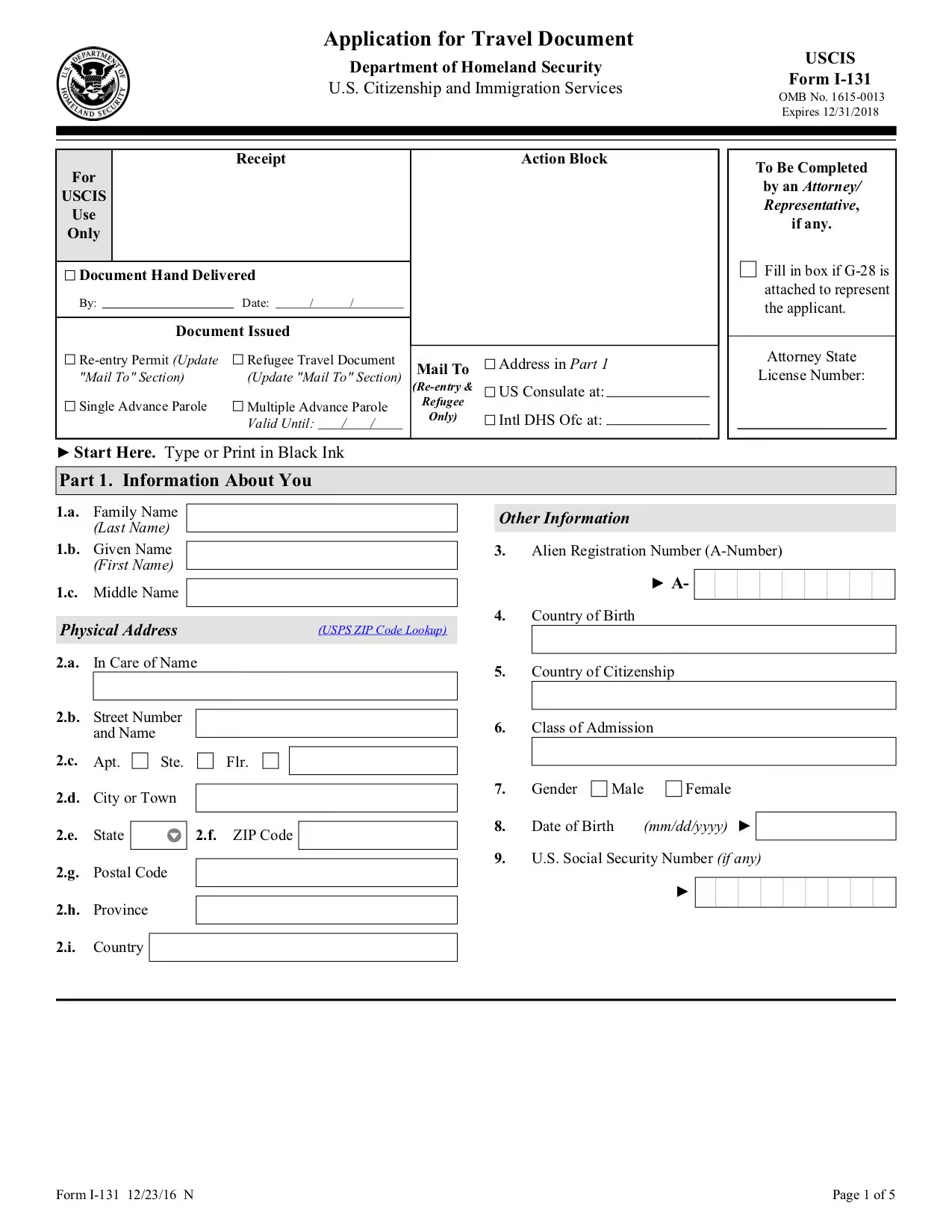
Basic Form I-131 Checklist:
- A copy of your filled out Form I-131
- Identity documentation: a copy of an official document which shows your photo, name, and date of birth. For example, a current Employment Authorization Document, a valid driver’s license, the passport identity page, Form I-551, or a Permanent Resident Card.
- Photographs
- Biometrics Services (Please note: there is a biometrics services fee for those applicants between 14-79 seeking Reentry Permits and/or Refugee Travel Documents..)
- Filing Fee
Reentry Permit Checklist:
You need to attach a copy (front and back) of your Form I-551.
If you do not have your I-551 you have 2 options:
- Include a copy of the biographic pages of your passport and the visa page that shows your initial admission as a lawful resident; OR
- A copy of your Form I-797
Refugee Travel Document Checklist:
Attach a copy of the document showing your refugee (or asylee) status. This document should have been issued to you by the USCIS. It should include the expiration date of your refugee status.
If you are younger than 16 your filing fee will be $105. If you are 16 or older it will be $135.
Note: The application fee may not be required. This is true if you payed the fee and filed Form I-485 on or after 30 July 2007 and your I-485 is still pending. You must also now hold US refugee or asylee status.
Advance Parole Document Checklist:
The following requirements only apply for individuals who are currently in the US. You will need to attach:
- A copy of a document showing your current status in the US, issued to you by USCIS
- An explanation (or evidence) for the circumstances that prove why you qualify for an Advance Parole Document; OR
- If you are seeking an adjustment of status – a copy of the receipt from USCIS. This receipt proves you filed the adjustment application; OR
- If you are traveling to Canada to apply for an immigrant visa – a copy of the appointment letter from the US consular; OR
- If your case has been deferred – under DACA by USCIS, include a copy of your I-797. If your case has been deferred by ICE, include a copy of your approval order, notice, or letter issued by ICE.
- You must also complete Part 4 for the I-131, and include evidence to support your claim. There are 3 accepted purposes:
- Educational: include a letter from the school describing the purpose of travel and why your travel is necessary. OR include a document showing your in enrollment in a program that requires travel.
- Employment: include a letter from your employer or conference host describing the need for travel.
- Humanitarian: include a letter from your physician explaining your medical condition, the treatment you are seeking, and why your travel is medically necessary. OR include documentation of a family member’s illness or death.
- Your filing fee will be $575.
If you are seeking an Advance Parole Document and you are outside the US you have a couple of options. You make file under a Family Reunification Parole policy or not.
- Under one of the Family Reunification Parole policies you will need to attach:
- For HFRP: the completed document described by the HFRP Program in the application instructions of their invitation letter
- For CFRP: the completed document described by the CFRP Program in the application instructions of their invitation letter
- For the FWVP Program:
- A copy of your I-797 or a printout from Case Status Online
- Your completed Form I-134
- Evidence that the WWII service from the Filipino veteran was previously recognized by the US Army. This service is to be defined by section 405 of the Immigration Act of 1990, as it is amended.
- Evidence of your marriage and a copy of your spouse’s death certificate. If you are the surviving spouse of the Filipino WWII veteran
- If you are not filing under one of the Family Reunification Parole polices listed above you will need to include:
- For humanitarian or significant public benefit reasons:
- A detailed description of why such a situation requires an Advance Parole Document
- An explanation of the length time for which you are requesting the parole
- Copies of evidence that show the basis of your request.
- Your Form I-134
- A statement explaining why you cannot obtain a US visa. This statement should include when and where you have tried to obtain a visa. Or an explanation for why you did not seek a visa when entering the US.
- If it applies to you, include a statement explaining why a waiver of inadmissibility cannot be obtained. Include when and where you a have attempted to obtain a waiver, and a copy of any DHS decisions about your waiver request. Or an explanation for why you have not sought a waiver.
- A copy of any decision on an immigrant or non-immigrant petition or application and evidence regarding a pending petition or application.
- And, unless the evidence submitted showing your photo, name, and date of birth was your passport, you will need to include:
- A copy of the biographical page of your beneficiary’s passport. If their passport is not available, provide an explanation for why and include a different government-issued identity document that shows the beneficiary’s citizenship.
- Copies of your and your Form I-134 sponsor’s official identity documents and evidence of your sponsor’s citizenship or US immigration status. This could be a copy of a US passport, lawful permanent resident card, or birth certificate.
- For humanitarian or significant public benefit reasons:
Note: If you are filing for an Advance Parole Document, the application fee may not be required. This is true if, you payed the fee and filed Form I-485 on or after 30 July 2007 and it is still pending. You must also be returning to the US after temporary foreign travel. In this case, you may file your I-131 with your I-485. Or you can submit your I-131 later. You will then need to submit a copy of your I-797 to show you paid your I-485 fee.
Ways to fill out and submit Form I-131:
Fill Out On a Computer
Download and view in a PDF viewer.
Download PDF
SimpleCitizen's Application Builder
Form I-131 is included with SimpleCitizen.
Get Started*Includes Attorney Review
Print & Fill Out Paper Form
Print the PDF and fill by hand with black pen.
Print PDF
Hire a Legal Professional
Find a legal professional to complete the form.
Visit AILA.com
What is the Green Card Lottery?
Understanding the basics of the Visa Lottery Program
General Immigration Information
Last Updated: May 12, 2020
To many hopeful immigrants around the world, the Green Card Lottery is the “golden ticket” for entry into the United States. In many ways, Green Card Lottery, officially known as the Diversity Immigrant Visa program is a cheap and straightforward way to enter the U.S. Applying is free and fewer forms are needed than for the family-sponsored or employer-sponsored visas. The application window for the 2017 fiscal year closed in November and more than 19 million hopefuls applied for the Lottery. Only 50,000 visas will be awarded. Which means, only 1 in 386 applicants will be awarded a visa. For many people, it is the best or only way to immigrate into the country. This is our comprehensive guide for getting a green card through the Green Card Lottery.
The Basics
What is the Green Card Lottery?
The Green Card Lottery, officially, the Diversity Immigrant Visa program is enacted in section 203(c) of the Immigration and Nationality Act and codified in title 8 section 1153 of the United States Code. President H. W. Bush signed it into law back in 1990. It came after a series of temporary diversity programs, as an attempt to broaden the range of admitted immigrants. At the time, it especially helped the Irish fleeing their country due to unrest.Although Diversity Immigrant Visa program is the official name, it is often referred to as the Diversity Visa Lottery or the Green Card Lottery, or some mixture of these terms. Immigrant visas awarded are often called diversity visas.To summarize the process, applicants apply; applicants are selected at random using a computer; selected applicants are then screened through an interview process; those that pass the screening process are awarded immigrant visas; upon entry into the U.S., they are awarded their green card.So, it is called both a visa lottery as well as Green Card lottery because winners are first given a visa which is then upgraded to a Green Card upon entry into the U.S.Officially, 55,000 visas are awarded, however, each year 5,000 goes to the NACARA program, dropping the available number down to 50,000. The Green Card Lottery is one of several peripheral immigration programs that exist outside the more common route of family or employer sponsorship.The Diversity Visa Lottery has come under some scrutiny lately and some lawmakers are even calling for it to end. Sayfullo Saipov infamously entered the country through the Diversity Lottery and then used his vehicle to slaughter innocent people in an act of terror.Read more about Trump’s bill to end the program.
What is a green card?
A green card is an identification card carried by lawful permanent residents. They receive it when they become authorized to live and work in the U.S. on a permanent basis. Perhaps most importantly, green card holders can apply for U.S. citizenship.The Green Card lottery compresses hassle of getting a visa and then obtaining a green card into a single process. About 1 million people are granted lawful permanent residency each year, so the Lottery makes up about 5% of those receiving green cards each year.Go here for our complete guide on getting a green card.
The Application for the Green Card Lottery
As visa applications go, applying for the Diversity Visa Lottery straightforward. It can be broken down into four main parts
- Submitting your application
- Getting selected
- Passing the interview
- Receiving your Green Card
Submitting your application
Each year, the U.S. Department of State publishes here the instructions on that year’s application process. Because the process takes a couple years, application years are given the name of the year in which their applicants will enter the U.S. So the application open in 2018 will be called DV-2020 because winners will enter the U.S. in 2020.To apply, you’ll submit your Electronic Diversity Visa Entry Form, E-DV Entry Form or DS-5501, online at dvlottery.state.gov. Applications can only be done online, only one entry is allowed per person, and submitting an application is free. Usually, the application process is only open for a limited time from October to November.The online application will ask you for basic background information including:
- Name
- Gender
- Birthdate
- City where you were born
- Country where you were born
- Country of eligibility for the Diversity Visa program
- Entrant photographs – these are individual photographs taken within the last six months of yourself, your spouse, and each of your children.
- Mailing Address
- Country where you live currently
- Phone number (optional)
- Email address
- Highest level of education you have achieved
- Current marital status
- Number of children
Married children and children who are already aged 21 or older when you submit your entry are not eligible to be included on your application.Most importantly, you must meet the three basic requirements. You must:
- Be able to apply from an eligible country
- Have completed high school OR have two years work experience
- Be admissible
Requirement #1: The visa lottery countries
Not all countries are eligible for the green card lottery. Because the green card lottery is designed to admit immigrants from less common countries, countries with the highest rates of immigration are prohibited. The State Department uses a fairly complex formula to determine high-admission and low-admission countries and regions. If more than 50,000 immigrants have come from a country in the last five years, then that country will be ineligible.Areas with the fewest number of immigrants are prioritized. This equation has lately favored Africa and Eastern Europe and consistently disfavored the most populous countries. No single country may receive more than 3,500 DVs.In 2019, on the prohibited list was:
- Bangladesh
- Brazil
- Canada
- China (mainland-born)
- Colombia
- Dominican Republic
- El Salvador
- Haiti
- India
- Jamaica
- Mexico
- Nigeria
- Pakistan
- Peru
- Philippines
- South Korea
- United Kingdom (except Northern Ireland) and its dependent territories
- Vietnam
Natives from all other countries are eligible to apply. If you are from one of the prohibited countries, do not despair. Your country may be taken off the list in the future. Also, there are two other ways you might be able to qualify.
- Use your spouse’s country. If your spouse was born in an eligible country then you can claim your spouse’s country of birth. For this to work, both you and your spouse must be named on the selected entry, be found eligible and issued diversity visas, and enter the United States simultaneously.
- Use your parents’ country. If you were you born in an eligible country, but your parents were neither born in nor residents of that country, then you can claim the country of birth of one of your parents.
Requirement #2: School or work experience.
An applicant must also meet the second requirement. This can be done in one of two ways.
- Graduated from high school. You must have at least a high school education or its equivalent. This means you must have successfully completed a 12-year course of formal elementary and secondary education
- OR two years work experience. You must have two years of work experience within the past five years, in an occupation that requires at least two years of training or experience to perform.
For this second requirement, the State Department uses the U.S. Department of Labor’s O*Net Online database to determine qualifying work experience. It requires two years of training or experience that is designated as Job Zone 4 or 5, classified in a Specific Vocational Preparation rating of 7.0 or higher.
Requirement #3: Admissibility
Additionally, an applicant must be admissible to the US -- categories of inadmissibility to the US broadly include terrorism connections.Generally speaking, to be admissible, an applicant must not be inadmissible.The main categories of inadmissibility include health, criminal activity, national security, public charge, lack of labor certification, fraud and misrepresentation, prior removals, unlawful presence in the United States, and several miscellaneous categories. Sometimes, a person may apply for a waiver.
Getting Selected
The INA requires diversity visas to be distributed “strictly in a random order.”Around May 15 each year, applicants are notified through the online portal if their applications are accepted. For the few that are selected to continue the application process, this is a happy day; for the many not selected, they hope to find better luck in the year to come.It is important to note that not all selected at this stage will ultimately be submitted. About 100,000 applicants are selected at this stage. They will be narrowed down to 50,000. Try not to get ahead of yourself by selling your house, car, or other properties, quitting your job, or making travel arrangements; don’t do any of that stuff until after you actually have your visa.To proceed in the process, selected applicants must complete the online Form DS-260 application immediately to schedule an interview appointment at the appropriate U.S. Embassy or Consulate.
Passing the Interview
The next step in the process is the in-person interview. At this point, a fee is required to continue on to the interview: $330 per person. Each family member who will accompany the applicant to the U.S. must be present.Fingerprints are recorded at the interview.An applicant must bring many things with them to the interview:
- Appointment Letter - Snag this from your appointment information from the Entrant Status Check on the Electronic Diversity Visa (E-DV) website.
- DS-260 Confirmation Page - Print this from the Consular Electronic Application Center any time after you complete your DS-260 application.
- Passport - You must have for each applicant an unexpired passport valid for six months beyond the intended date of entry into the United States.
- Photographs - Two identical color photographs for each applicant. Go here for requirements.
- Medical Exam Results - You and each family member applying for a visa with you must schedule a medical appointment with an authorized physician in the country where you will be interviewed. This examination and required vaccinations must be completed before your interview. The results may be mailed to the Embassy or Consulate or you may need to bring them with you yourself.
Beyond this, a long list of documents is required. For each document, you must have:
- An original or certified copy
- A photocopy
- A certified translation, if the original document is not in english.
Required documents could include all applicable civil documents
- Documents demonstrating the requisite qualifying education or work experience
- Birth certificates
- Court and prison records
- Deportation documentation
- Marriage certificate
- Marriage termination documentation
- Military records
- Police records
- Custody documentation
Read this to understand consular processing.
Receiving your Green Card
At the end of the interview, the consular officer will inform you whether your visa application is approved or denied. If denied, then your passport comes back empty. If approved, your passport will be returned to you with a nice, new, beautiful visa.Time to pack your bags! You are coming to America.A diversity visa is usually valid for up to six months. So an applicant must arrive and apply for admission in the United States before the expiration date on the visa.Of course, there is one more fee. You must pay the USCIS Immigrant Fee to USCIS after you receive your immigrant visa and before you travel to the United States. Currently, it’s $220.The primary applicant must come before or at the same time as other family members with visas. At this point, your diversity visa will grant you entry to the U.S., although that entry is not 100 percent guaranteed. Any immigrant still must conform with the Customs entry requirements.If you are admitted, you will now be a lawful Permanent Resident, a green card holder. Congratulations!After you are admitted to the United States, USCIS will mail your green card to the address you provided to the State Department at the time of your immigrant visa interview or to Customs at the time you arrived in the United States.You will be allowed to work and live permanently in the United States.
What if I’m already on a visa in the U.S. and I win the Green Card Lottery?
If you are already in the U.S. under a lawful immigrant or nonimmigrant status and you win the green card lottery, you can apply for a change of status to receive your green card. This process is done through USCIS. Your application with USCIS must be completed by September 30 of the fiscal year the lottery pertains to.You must:
- Have won the Green Card Lottery
- Have an immigrant visa immediately available at the time of filing an adjustment application Form I-485, and
- Be admissible to the United States.
To obtain the Green Card, you must file Form I-485, change of status request. Read this tutorial.You’ll need to provide these documents:
- Two passport-style photos
- Copy of birth certificate
- Form I-693, Report of Medical Examination and Vaccination Record
- Copy of passport page with nonimmigrant visa (if applicable)
- Copy of passport page with admission (entry) or parole stamp (if applicable)
- Form I-94, Arrival/Departure Record
- Certified copies of court records (if you have been arrested)
- Copy of your selection letter for the Lottery
- Copy of the receipt for the diversity visa lottery processing fee
- Form I-601, Application for Waiver of Grounds of Inadmissibility (if applicable)
- Applicable fees
The Happy Ending
Now that you have a Green Card, you must keep it safe and keep it in your possession at all times. It is valid for 10 years.You should renew your green card when it has 6 months left or request a new one if it was lost or stolen by filing the Form I-90You can use your Green Card to:
- Prove employment eligibility in the United States when completing the Form I-9
- Apply for a Social Security Card
- Get a state-issued driver’s license.
- Re-enter the U.S. after a trip abroad if you do not leave for longer than 1 year. If your trip will last longer than 1 year, a reentry permit is needed.
- Sponsor family members to come on over next!
Form I-131 Travel Application Guide
A guide to Form I-131, Application to Travel.
USCIS Forms
Last Updated: January 15, 2020.
What is the Form I-131 Travel Application?
Form I-131 is a travel application. This travel document often is used by green card holders.
You can use it to apply for a re-entry permit, refugee travel document or advance parole travel document.
- A Re-entry permit enables a lawful permanent resident or conditional permanent resident (Green Card Holders qualify for both of these categories) to apply to be admitted into the United States, after returning from travel abroad, without the need to obtain a returning resident visa from a U.S. Embassy or U.S. Consulate.
- A Refugee Travel Document can be allotted to an individual in valid refugee or asylee status, or to a lawful permanent resident who obtained refugee or asylee status in the United States.
- Individuals who hold asylee or refugee status and are not lawful permanent residents must have a Refugee Travel Document to return to the United States after travel abroad, unless they possess an Advance Parole Document.
- You should apply for a Refugee Travel Document BEFORE you leave the United States.
- An Advance Parole Travel Document allows you to physically enter into the United States for a specific purpose without applying for a visa.
- This document can authorize you to appear at a port of entry to seek parole into the United States. However, someone who has been “paroled” has not been permanently admitted to the United States and remains an “applicant for admission” even while paroled.
- Although the document may be accepted by a transportation company instead of a visa as permission to travel to the United States, an Advance Parole Document cannot replace a required passport. Most Advance Parole Documents are issued for multiple entries; however; some are issued for single entries.
Form I-131 is Included with SimpleCitizen.
What supporting documents do I attach to Form I-131?
You will need the following documents in order to fill out and submit I-131:
- Your application with the filing fee.
- A copy of an official photo identity document showing your photo, name, and date of birth
- These include: your current Employment Authorization Document, if available; a valid government-issued driver’s license; passport identity page; Form I-551, Permanent Resident Card; or any other official identity document.
- Form I-94 Arrival-Departure Record is not acceptable as a photo identity document.
Document Upload is Included with SimpleCitizen.
Additional Documentation Required for Reentry Permit Application:
- A copy of the front and back of your Form I-551; OR
- If you have not yet received your Form I-551, a copy of the biographic pages of your passport and a copy of the visa page showing your initial admission as a lawful permanent resident, or other evidence that you are a lawful permanent resident
- A copy of the Form I-797, Notice of Action, approval notice of an application for replacement of your Form I-551 or temporary evidence of lawful permanent resident status.
Additional Documentation Required for Refugee Travel Document Application:
- A copy of the document issued to you by USCIS showing your refugee or asylee status and the expiration date of this status.
Additional Documentation Required for Individuals Currently In the U.S.:
- A copy of any document issued to you by USCIS showing your present status, if any, in the United States; AND
- An explanation or other evidence showing the circumstances that warrant issuance of an Advance Parole Document; OR
- If you are an applicant for adjustment of status, a copy of a USCIS receipt to prove that you filed the adjustment application; OR
- If you are traveling to Canada to apply for an immigrant visa, a copy of the U.S. consular appointment letter; OR
- If USCIS has deferred action in your case under DACA, you must include a copy of the Form I-797 (Notice of Action) showing that the decision on your Form I-821D was to defer action in your case. If ICE deferred action in your case under DACA, submit a copy of the approval order, notice or letter issued by ICE.
Additional Documentation Required for Individuals Outside of the U.S.:
- A detailed description of why you are requesting an Advance Parole Document (urgent humanitarian reasons, significant public benefit reasons), an explanation for the length of time for which parole is requested, and copies of any evidence and documentation that supports the reasoning behind your request.
- Form I-134 (Affidavit of Support)
- A statement explaining why a U.S. visa cannot be obtained, including when and where attempts were made to obtain a visa, or an explanation of why a visa was not sought to enter the United States
- If applicable, a statement explaining why a waiver of inadmissibility cannot be obtained to allow issuance of a visa, including when and where attempts were made to obtain a waiver, and a copy of any DHS decision on your waiver request, or an explanation of why a waiver has not been sought
- A copy of any decision on an immigrant or non-immigrant petition or application filed for an individual seeking to enter the United States, and evidence regarding any pending immigrant or non-immigrant petition or application
- In addition to the identity document described in Item 1. Initial Evidence above, unless such document is a valid passport:
- A copy of the biographical page of the beneficiary’s passport or, if it is not available, an explanation why a passport is not available and another government-issued identity document that establishes the beneficiary’s citizenship; and
- Copies of the petitioner’s and Form I-134 sponsor’s official identity documents and evidence of their citizenship or U.S. immigration status (such as a copy of a U.S. passport, lawful permanent resident card, or birth certificate).
What is the processing time for Form I-131?
USCIS does not specify an average processing time for review and acceptance of Form I-131. However, USCIS processes forms in the order in which they are filed, so the sooner you submit your form, the faster it’ll be approved.
What is the Form I-131 mailing address?
You may submit Form I-131 by mail or online to USCIS. The direct filing addresses differ based on the type of travel document for which you are applying and immigration status you hold. You can find direct filing addresses on the USCIS website. For online applications, information about where to send your supporting documentation is provided when you submit your application electronically. You will be provided with a confirmation sheet when you submit your application online and you must place a copy of this confirmation sheet on top of your supporting documentation when you mail it to USCIS.
What is the Form I-131 class of admission?
The Form I-131 class of admission refers to the visa category by which you were admitted as an immigrant to the United States as a permanent resident or conditional permanent resident.
How long does my travel authorization last as granted through Form 1-131?
Travel authorization lasts for different periods of time for the following documents:
- Typically, a Reentry Permit issued to a lawful permanent resident is valid for 2 years from the date of issuance. It may not be extended.
- A Refugee Travel Document is valid for 1 year. It may not be extended.
- An Advance Parole Travel Document is valid for up to 1 year. Individuals may be granted a multiple entry or a single entry document.
What is the Form I-131 filing fee? Do I qualify for a fee waiver?
The Form I-131 filing fee ranges from $105 to $575 depending on your age and type of travel application you are requesting. Biometric service appointments are required in all cases and cost either nothing or $85 depending again on your age and type of travel application. You do not need to pay a fee to file Form I-131 under the following conditions:
- You are filing Form I-131 Application Type B or D.
- You filed a Form I-485 with a fee on or after July 30, 2007.
- Your Form I-485 is still pending.
You may qualify for a fee waiver under 8 CFR 103.7(c). If you are eligible for a fee waiver, complete and submit Form I-912 (Request for Fee Waiver) with any required evidence of your inability to pay the filing fee with this application. You can review the fee waiver guidance at https://www.uscis.gov/feewaiver.
What if my documentation is in a language other than English?
Any document containing foreign language must be accompanied by a full English language translation which the translator has certified as complete and accurate. You must also include the translator’s certification that he or she is adequately able to translate from the foreign language into English.
Certified Document Translation is Included with SimpleCitizen.
What do I do after I fill out I-131?
After processing your application for a Reentry Permit, USCIS will inform you in writing when to go to your local Application Support Center (ASC) for your biometrics services appointment. This appointment is to gather physical data by which a person can be uniquely identified. At your biometrics appointment, USCIS will collect your fingerprints, take your photo, and have you sign your name for electronic capture. You must attend the biometrics services appointment in order to finalize your travel authorization. If you do not attend the appointment, your application may be denied.
Ways to fill out and submit Form I-131:
Fill Out On a Computer
Download and view in a PDF viewer.
Download PDF
SimpleCitizen's Application Builder
Form I-131 is included with SimpleCitizen.
Get Started *Includes Attorney Review
Print & Fill Out Paper Form
Print the PDF and fill by hand with black pen.
Print PDF
Hire a Legal Professional
Find a legal professional to complete the form.
Visit AILA.com
Don’t Forget:
- Upon returning to the United States, most people must present a valid H, L, K, or V nonimmigrant visa for re-entry.
Form I-765 EAD Step by Step Guide
Understanding the basics of submitting Form I-765, Application for Employment Authorization.
USCIS Forms
Last Updated: July 9, 2020.
What is Form I-765?
Form I-765 is the application for employment authorization.
What is employment authorization?
Employment authorization is when USCIS gives temporary authorization for employment to non-citizens. Immigrants can use Form I-765 to request an employment authorization document (EAD). This document grants the non-citizen temporary employment authorization in the United States.
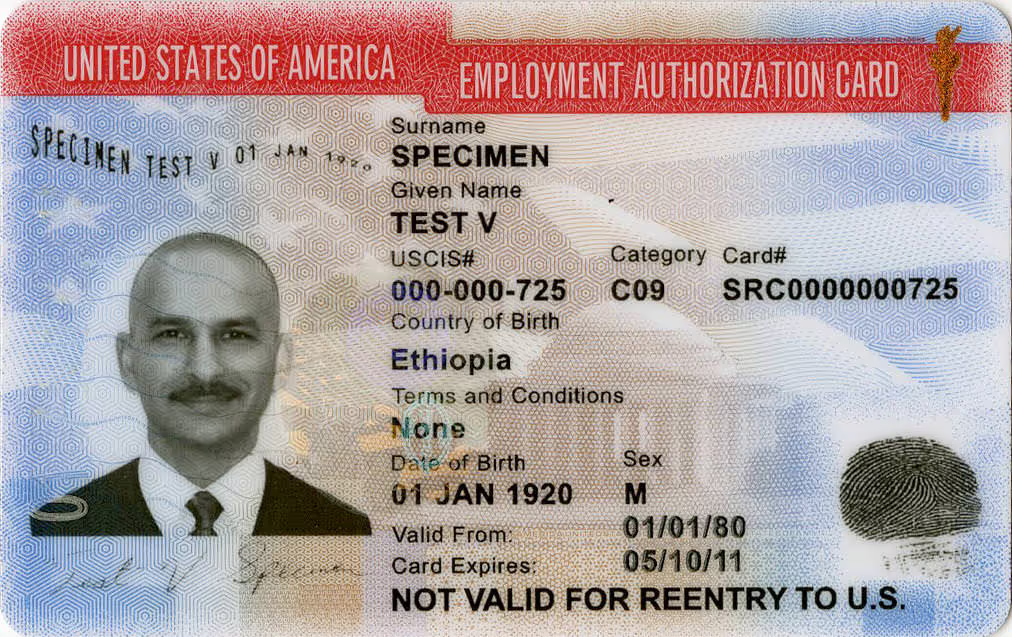
Do I have to submit the Form I-765?
You must apply for an EAD with Form I-765 if you:
- Are approved to work in the United States due to your immigration status (asylee, refugee, or nonimmigrant) and need evidence of that employment authorization.
- Need to apply for permission to work, or to request employment authorization. You may have a:
- pending Form I-485, Application to Register Permanent Residence or Adjust Status.
- pending Form I-589, Application for Asylum and for Withholding of Removal.
- a nonimmigrant status that does not allow you to work in the United States without first seeking permission from USCIS (such as an F-1 or M-1 student).
You do NOT need to apply for an EAD if you are a lawful permanent resident, conditional resident, or nonimmigrant. Your Green Card provides sufficient proof of your employment authorization. You also do NOT need to apply for an EAD if you possess a nonimmigrant visa that authorizes you to work for a specific employer (for example, an H-1B, L-1B, O, or P visa).
Can I work while my Green Card application is processing?
Processing Timeline: USCIS previously issued work authorization within 90 days, but their current processing time averages 4-7 months. While it can be frustrating to wait that long to receive work authorization, these processing times are shorter than the current green card wait times and are meant to make the wait time for the green card a little easier.
Required Supporting Documents
You will need the following documents in order to submit I-765:
- Your application with the filing fee.
If you are mailing your application to USCIS, you must also submit the following documentation, according to USCIS:
- A copy of Form I-94, Arrival-Departure Record (front and back), if available. If you are filing Form I-765 under the (c)(9) category, Form I-94 is not required.
- A copy of your last EAD (front and back). If no prior EAD has been issued, you must submit a copy of a government-issued identity document, such as a passport showing your picture, name, and date of birth; a birth certificate with photo ID; a visa issued by a foreign consulate; or a national ID document with photo and/ or fingerprint. The identity document photocopy must clearly show the facial features of the applicant and the biographical information. If you are filing under the (c)(33) category, additional documentation is not required.
- You must submit two identical color photographs of yourself taken within 30 days of filing your application. The photos must have a white to off-white background, be printed on thin paper with a glossy finish, and be unmounted and un-retouched. The passport-style photos must be 2” by 2”. The photos must be in color with full face, frontal view on a white to off-white background. Head height should measure 1” to 1 3/8” from top to bottom of chin, and eye height is between 1 1/8’ to 1 3/8” from bottom of photo. Your head must be bare unless you are wearing headwear as required by a religious order of which you are a member. Using pencil or felt pen, lightly print your name and Alien Receipt Number on the back of the photo.”
What is the Form I-765 filing address?
If you're filing the form directly, the address depends on the eligibility category you entered in Question 16 of Form I-765. If you are filing I-765 with another form, file both documents at the location required by the other form. Use the addresses found on the USCIS website only when you are not submitting I-765 with another form.
How much is the Form I-765 filing fee?
There are multiple different fee categories for Form I-765 depending on the circumstances of the filing. In general, the filing fee of Form I-765 ranges from $0-$520.
If an applicant submits the Form I-765 with a family-based green card application (Form I-485), then typically it would cost $520 for paper filing and $470 for online filing. Subsequent Form I-765 renewals associated with the pending Form i-485 have a fee of $260, whether filed by paper or online method.
Can I get the fee waived?
You may qualify for a fee waiver if you provide documentation for any of the following eligibility criteria:
- You, your spouse, or the head of household living with you, are currently receiving a means-tested benefit.
- Your household income is at or below 150 percent of the Federal Poverty Guidelines. Check the current Federal Poverty Guidelines for this year to see if your household income qualifies.
- You are currently experiencing financial hardship that hinders you from paying the filing fee, such as unexpected medical bills, emergencies, and other unforeseen circumstances.
You may file for a fee waiver by filling out Form 912 (Request for a Fee Waiver).
- There is no filing fee for this form.
- You cannot file online if you are requesting a fee waiver. You will need to file paper versions of the fee waiver request and the form for which you are requesting a fee waiver, together. Do not file the two forms separately.
- Each person applying for a fee waiver must sign and date the Form I-912.
Instead of filing Form-912, you may also file for a fee waiver by writing a letter with all the necessary information that states your request for a fee waiver, is signed by everyone requesting the fee waiver, and includes all the necessary supporting evidence.
For further information on proof of documentation and eligibility, check the USCIS Fee Waiver information sheet.
How do I renew my I-765?
If your EAD has expired or will be expiring soon, you can submit a new Form I-765 and filing fee (unless a fee waiver has been requested and granted) to file for a renewal EAD. Do not file for a renewal EAD more than 180 days before your initial EAD expires.
How do I request a replacement EAD?
You may follow the renewal process listed above to request a replacement EAD for lost, stolen, or destroyed documents. If your EAD contains incorrect information that is not due to a USCIS error, you must submit a new I-765 form, a filing fee, the required documentation, and the card containing the error.
If your EAD contains incorrect information that is due to a USCIS error, you do NOT need to submit a new I-765 form or a filing fee. USCIS will process your replacement request at no cost. In this case, you must send the original card containing the error, a detailed written explanation of the card error, and supporting documentation on the correct information. Submit this information to the service center or National Benefit Center that approved your latest Form I-765.
What if my documentation is in a language other than English?
Any document containing foreign language must be accompanied by a full English language translation which the translator has certified as complete and accurate. You must also include the translator’s certification that he or she is adequately able to translate from the foreign language into English.
Do I receive updates when USCIS has accepted my Form I-765?
Yes. To do so, fill out Form G-1145 (E-Notification of Application/Petition Acceptance) and attach it to the first page of your I-765 application.
Don't Forget:
- You must complete all sections of the form. The form will be rejected if any of these fields are missing:
- Number 1 – Full Name
- Number 3 – U.S. Mailing Address
- Number 6 – Date of Birth
- Number 20 – Eligibility Category
- Remember to sign your form! USCIS will reject and return any unsigned form.
- Biometrics Services Appointment: After receiving your application and ensuring completeness, USCIS will inform you in writing when to go to your local USCIS Application Support Center (ASC) for your biometrics services appointment. This appointment is to gather physical data by which a person can be uniquely identified. At your biometrics appointment, USCIS will collect your fingerprints, take your photo, and have you sign your name for electronic capture. If you do not attend the appointment, your application may be denied.
How to Travel After Submitting Form I-131
Here's a simple guide to international travel after submitting Form I-131.
USCIS Forms
Last Updated: May 13, 2022.
So you've submitted your Form I-131 and are ready to travel outside of the United States. But where exactly can you go? Here's a simple guide to international travel after submitting Form I-131.
Getting your Travel Document
Submitting Form I-131 alone isn't going to allow you to travel. Form I-131 is actually an application for a travel document, which you can use for some types of travel. There are four different types of travel documents that you can get, based on your immigration status:
- Advance Parole
- Refugee Travel Document
- Re-entry Permit
- Carrier Documentation
Traveling with a Travel Document
So where can you go with a travel document? It depends. Each country decides its own policy in regards to U.S. travel documents. Some countries will require a tourist visa, others will not. Some countries also require immunizations or have other travel requirements.In general, you should plan your trip carefully to make sure you'll meet the travel requirements for each country that you're planning on visiting. Check out the Department of State's website for information about countries and their travel requirements. Don't forget that if you have a passport from your country of origin, you can use that for international travel as well.
Returning to the United States
The most important thing that your travel document does is that it lets you get back into the U.S. after your trip is over. If you don't have a travel document with you, you'll have a hard time getting back in. That's why it's important to submit Form I-131 and receive your travel document BEFORE you leave.If you're a lawful or conditional permanent resident and are planning to be abroad for over a year, you should apply for a Re-entry Permit. This will allow you to apply for admission to the U.S. after your trip without having to get a returning resident visa. For more instructions on traveling outside the U.S. for lawful permanent residents, click here. If your Re-entry Permit or green card is lost or destroyed while you're abroad, you'll need to submit Form I-131A, which will allow you to get Carrier Documentation. Carrier Documentation is basically a travel document that you can show to an airline or other transportation service so that they'll take you to the U.S.If you have asylum or refugee status and are NOT a lawful permanent resident, you'll need a Refugee Travel Document to get back into the U.S. unless you have an Advance Parole Document.If you're still in the process of adjusting your residency status or applying for asylum, you'll need an Advance Parole Document. If you leave the country without an Advance Parole Document, your application will be considered abandoned unless you fall into one of these categories:
- H-1 temporary worker (or H-4 spouse or child of H-1)
- L-1 intracompany transferee (or L-2 spouse or child of L-1)
- K-3 spouse or K-4 child of a U.S. citizen
- V-1 spouse or V-2/V-3 child of a lawful permanent resident
If you do fall into one of these categories, you'll still need to present your valid nonimmigrant visa upon returning to the U.S.Enjoy your trip!
Ways to fill out the Form I-131
Fill Out On a Computer
Download and view in a PDF viewer.
Download PDF
SimpleCitizen's Application Builder
Form I-131 is included with SimpleCitizen.
Get Started*Includes Attorney Review
Print & Fill Out Paper Form
Print the PDF and fill by hand with black pen.
Print PDF
Hire a Legal Professional
Find a legal professional to complete the form.
Visit AILA.com
Green Card Joint Sponsor Requirements
Learn more about USCIS's Green Card Financial Sponsor Requirements
Green Card Application
People ask us all the time how to fill out the I-864 as a joint sponsor. So we decided to help answer this question in this detailed guide. Most immigrants enter the country on a family-sponsored visa. In this case, a family member who is a lawful permanent or U.S. citizen will file a visa petition for the hopeful applicant. In order to enter the U.S., the applicant must not be inadmissible. One way an immigrant can be inadmissible is if she is a “public charge.” If an immigrant is a public charge then, generally speaking, she or he is viewed by the government as being at risk of becoming a burden on society. An applicant must prove that they will not be a public charge.This is done by acquiring financial sponsors, and in some cases joint sponsors, and having your sponsors file an I-864 verifying that you will not be a public burden. Joint sponsors are very similar to regular sponsors. First we'll discuss regular sponsors, and then we'll discuss joint sponsors.
Form I-864, Affidavit of Support
Section 213(a) of the INA requires an affidavit of support. USCIS has created this affidavit in the form of the I-864. This is a form filled out by the sponsors of a hopeful immigrant and is submitted with most family-sponsored applications. Its purpose is to show that there is sufficient financial support for the immigrant and that there will not be a need for financial assistance from the U.S. Form I-864 is supported and included with SimpleCitizen.
Ways To Fill Out Form I-864
The I-864 comes with its own instructions, but those can be confusing. There are a few ways this form can be tackled:
Fill Out On a Computer
Download and view in a PDF viewer.Download PDF
SimpleCitizen's Application Builder
Form I-864 is included with SimpleCitizen.
Get Started *Includes Attorney Review
Print & Fill Out Paper Form
Print the PDF and fill by hand with black pen.Print PDF
Hire a Legal Professional
Find a legal professional to complete the form.Visit AILA.com
What is a Sponsor?
Obligations of an I-864 Sponsor
To become a sponsor is to accept a legal obligation with the U.S. government and with the intending immigrant. A sponsor agrees to financially support the intending immigrant. Essentially, the sponsor agrees to provide the difference between the wages earned by the immigrant and 125 percent of the federal poverty level (FPL).This has a couple legal implications. First, if the immigrant does not make 125% FPL on their own, they can request or even sue a sponsor for that amount. Second, if the immigrant receives financial public assistance from a government agency, the sponsor may be requested to provide or sued for the amount equal to that assistance. This assistance may take the form of welfare, public housing, non-emergency Medicaid but does not include emergency Medicaid and short-term, non-cash emergency relief.Additionally, a sponsor must inform USCIS within 30 of any changes of address after the application until the obligation ends.
Qualifying as a Sponsor
To qualify as a sponsor, there are four basic requirements. A sponsor must:
- Be a US citizen
- Be at least 18 years old
- Be living in the US
- Have an annual income of at least 125% of the federal poverty level
Oftentimes, the main discussion regarding sponsorship focuses on whether a sponsor’s income is sufficient, specifically, whether it’s 125 percent of the FPL. As shown, This is dependent on two factors:
- Household size,
- Location, and
- Income.
These income requirements vary based on the size of one’s household and other factors like location. The exact income levels for 2025 for the contiguous US can be found in the following table:
| Sponsor’s Household Size | 100% of Federal Poverty Guidelines | 125% of Federal Poverty Guidelines |
|---|---|---|
| 2 | $21,150 | $26,437 |
| 3 | $26,650 | $33,312 |
| 4 | $32,150 | $40,187 |
| 5 | $37,650 | $47,062 |
| 6 | $43,150 | $53,937 |
| 7 | $48,650 | $60,812 |
| 8 | $54,150 | $67,687 |
Please note that active duty military need only meet 100 percent of the federal poverty level, and the levels are different for Alaska and Hawaii.(These numbers come from the Form I-864P, HHS Poverty Guidelines for Affidavit of Support. Take a look if your household is larger than 8 people.)
Determining household size
The basic idea of household size is determining the number of people in your home. It seems simple, but it can become technical. To determine household size count:
- You
- Your spouse
- Any children you have under the age of 21
- Any other dependents you claimed on your most recent Federal income tax return
- All lawful permanent residents you are currently sponsoring
- All lawful permanent residents you are applying to sponsoring
- (Optional) Other relatives living in your residence. Only include other relatives if you need to include their income.
Calculating Income
Again, the basic idea behind income is simple: it’s how much money a sponsor makes in a year. But it can become technical quick. To calculate a sponsor’s income add:
- Annual income earned by the sponsor
- Annual income earned by spouse
- Annual Income earned by other dependents in the household
- (Optional) Annual income earned by other relatives living in the sponsor’s residence
- (Under limited circumstances) Annual income earned in the U.S. by the intending immigrant and joined by a "Contract with Household Member."
Income can include:
- Wages
- Salaries
- Tips
- Taxable interest
- Ordinary dividends
- Alimony or child support
- Business income
- Capital gains
- Taxable IRA distributions
- Taxable pensions and annuities
- Rental income
- Unemployment compensation
- Workers compensation and disability
- Taxable Social Security benefits
Means-tested public benefits like food stamps, SSI, Medicaid, TANF and CHIP can not be included.In order to include the other relatives living at the sponsor’s residence, those members must complete a Form I-864A, Contract Between Sponsor and Household Member. Each one of these individuals must be over 18 years of age.
Last resort: Assets
If, after adding together all the incomes of all the household members of the sponsor, the income is still insufficient, then assets can be considered.To qualify, an asset must be convertible into cash within one year without being too difficult for the owner. Substantial evidence is required for assets to qualify. The net value of a house can be considered an asset; this equal to the appraised value of the home, minus all loans. The net value of a car may also be included, but the sponsor must show they own another car that is not included as an asset.For assets to work, they must equal at least five times the difference between a sponsor’s total household income and the 125 percent mark.Note: if your sponsor who filed the visa petition died, then you need to get a substitute sponsor to fill out I-864.If your sponsor does not have sufficient funds to sponsor you financially, you need to find a joint sponsor.
Adding a Joint Sponsor with Form I-864
So, once financial sponsors have counted the people in their household, added up their annual income, and made the calculation to determine whether their income is at least 125 percent of the federal poverty level, they might find that their income just isn’t over 125 percent, no matter how it’s calculated.If that’s the case, it is time to find a joint financial sponsor.A joint sponsor is very similar to a regular financial sponsor. A joint sponsor must:
- Be a US citizen
- Be at least 18 years old
- Be living in the US
- Have annual income of at least 125% of the federal poverty level (FPL)
A joint sponsor does not need to be a relative of the primary sponsor or of the intending immigrant. The joint sponsor must fill out an additional I-864.A joint sponsor’s income must independently be equal to 125 percent of the federal poverty level. The sum of the primary sponsor’s income and the joint sponsor’s income is unimportant. However, there can be up to two joint sponsors if more than one immigrant is coming; in that case, the incoming immigrants can be divided between the household sizes of the sponsors.In most ways, a joint sponsor is treated very similarly to a sponsor. Joint Sponsor forms are supported by SimpleCitizen.Applying for a Green Card? Read this.
The end of the obligation
Financial sponsors aren’t obligated to care for the immigrant for the rest of existence. The obligation ends when the sponsored immigrant:
- has worked ten full years
- becomes a U.S. citizen
- leaves the U.S. and no longer has permanent residence
- dies
- is deported and returns under a different sponsor.
- Or, the sponsor dies.
What happens if my sponsor becomes unemployed after submitting the I-864?
If your sponsor or joint sponsor becomes unemployed after submitting the I-864 and before the intending immigrant's approval, that is unfortunate. Technically, if after unemployment, the sponsored income is no longer above 125 percent, then USCIS will deny the application because the intending immigrant would become a public charge.But don’t despair yet; if income is no longer sufficient because of a change, the intending immigrant can ask for additional time to find additional income or for the sponsor to find a new job. The Consulate or USCIS will generally give an additional six months to a year before an application is declared dead.So, if possible, keep your job as a sponsor. Ideally, a sponsor will be able to show a stable work history, one suggests a sufficient income for the next 3-5 years. Switching jobs frequently or losing a job will place the intending immigrant in a “high risk” category, which may lead to a request for evidence or simply a denied visa.
Do You Meet the Requirements To Be a Sponsor?
Learn about the requirements for sponsoring a green card applicant here.
USCIS Forms
Last Updated: Feb. 7, 2020.
Do you have a family member that is applying for legal permanent residency?
Are you going to be the sponsor? Do you meet all the requirements to be a sponsor?
This guide will help you figure out if you meet the requirements for being a sponsor.
What is a financial sponsor?
Being a financial sponsor to an immigrant means the U.S. Government will consider your income and assets (such as checking and savings accounts, stocks, bonds, or property) as available to support the potential immigrant.
Who can sponsor? Who needs a sponsor?
You may sponsor a relative, an employee, or a prospective or currently adopted child wishing to immigrate to the United States. If you filed an immigrant visa petition for your relative, you must be the sponsor.
Anyone applying to be a permanent resident through a family member must have a financial sponsor. A sponsor is also required for a family member coming to work for a relative, or for a company in which a relative owns 5 percent or more of the company.
Am I eligible to become a sponsor?
To qualify to be a financial sponsor for a green card applicant, you must meet the following requirements:
- You must be at least 18 years old and a U.S. citizen or permanent resident.
- You must have a domicile in either the U.S. or a U.S. territory or possession (i.e. you must live there).
- You must prove an income level at or above 125 percent of the Federal poverty level (100 percent for active duty military personnel).
- You must submit an affidavit of support, which can be done by submitting Form I-864.
Income requirement to be a financial sponsor?
You must prove an income level at or above 125 percent of the Federal poverty level. (For active duty military personnel, the income requirement is 100 percent of the poverty level when sponsoring a husband, wife, or children.) Federal poverty levels are updated each year by the Department of Health and Human Services.
You can check current minimums at their website at www.aspe.hhs.gov.
What is Form I-864?
Form I-864 acts as an affidavit of support, which is a document an individual signs to accept financial responsibility for another person, usually a relative, who is coming to the United States to live permanently. The form proves that the immigrant has the financial means to live in the United States without needing welfare or financial benefits from the U.S. government. The person who signs the affidavit of support becomes the sponsor of the relative (or other individual) coming to live in the United States. The sponsor is usually the petitioner of an immigrant petition for a family member.
As the sponsor, you should fill out Form I-864 when your relative is about to submit an application for adjustment to permanent resident status with the USCIS or with an Immigration Court in the United States.
What if I don't meet the financial requirements?
If your income alone does not meet the requirement, your assets (such as checking and savings accounts, stocks, bonds, or property) may be considered in determining your financial ability. You may also submit the I-864 as a joint sponsor or a substitute sponsor.
What is a joint sponsor?
A joint sponsor is someone who is willing to accept legal responsibility for supporting your immigrating family member with you. A joint sponsor must meet all the same requirements as you; however, the joint sponsor does not need to be related to the immigrant.
The joint sponsor (or his or her household) must reach the 125% income requirement alone. You cannot combine your income with that of a joint sponsor to meet the income requirement.
Does a joint sponsor also need to fill out I-864?
Yes, a joint sponsor must also fill out Form I-864. Additionally, if you are using the income of other household members to qualify, then each household member must complete a separate Form I-864A.
What documentation do I need to fill out Form I-864?
You must provide the following documentation to fill out Form I-864:
- Your U.S. federal income tax return for the most recent tax year.
- Proof of current employment.
How do I submit Form I-864
Upon completing Form I-864, compiling the necessary documentation, and having the affidavit (or form I-864) notarized in the United States or before a U.S. consular or immigration officer, you should provide this packet of information to your relative to submit with his or her application for permanent resident status. If you are given specific instructions to file your affidavit of support directly with the National Visa Center, you should follow those instructions.
What is the cost to submit Form I-864?
There is no filing fee. However, the National Visa Center (NVC) does send the sponsor a processing fee before the case will be processed.
How long am I responsible for the immigrant?
The sponsor's legal financial responsibility usually lasts until the immigrant either becomes a U.S. citizen, can be credited with 40 quarters of work (usually 10 years), leaves the U.S. permanently, or dies.
Do I need to inform USCIS if I move or change addresses as a sponsor?
Yes, by legal requirement. If you change your address, you will need to file a Form I-865, Sponsor’s Notice of Change of Address, within 30 days after the date of your move.
What if I fail to provide financial support?
An affidavit of support is legally enforceable against a sponsor. If a sponsor does not provide basic support to the immigrants they sponsor, the individuals sponsored may receive “means-tested public benefits.” If the individual you sponsored receives any of these public benefits, you are responsible for repaying the cost of those benefits to the agency that provided them. If you do not repay the debt, the agency or sponsored immigrants can sue you in court to receive the money owed. When the immigrant sues, he or she can collect enough money to bring his or her income up to 125% of the amount listed in the U.S. government’s Poverty Guidelines.
Additionally, bankruptcy does not necessarily terminate a sponsor’s I-864 obligations. While most debts and contractual obligations are dischargeable in bankruptcy, “domestic support obligations” are not dischargeable. Such obligations are defined as alimony, maintenance, or support owed to or recoverable by one’s spouse, former spouse, or child. By United States court decisions, these also include I-864 support obligations.
Forms for Financial Sponsorship
- Form I-864 | Affidavit of Support Under Section 213A of the INA
- Form I-864A | Contract Between Sponsor and Household Member
- Form I-864EZ | Affidavit of Support Under Section 213A of the Act
- Form I-864P | HHS Poverty Guidelines for Affidavit of Support
- Form I-864W | Request for Exemption for Intending Immigrant's Affidavit of Support
Additional Facts and Data
- Of all 2015 accepted Green Card applicants, 44% were immediate relatives of U.S. citizens, 20% were other family members of citizens and lawful permanent residents, 14% were individuals in employment-related cases, 11% were refugees, and 3% were individuals granted asylum, according to a Pew Research Center study.
- Each year, the USCIS receives and processes about 6 million immigration applications from individuals and employers. According to the Department of Homeland Security (DHS), the United States issued green cards to nearly 1 million applicants in 2013. This number has remained relatively constant throughout the following years.
Green Card Sponsor Form I-864 Requirements
Learn more about filling out and submitting Form I-865 as a sponsor.
Green Card Application
Last Updated: January 15, 2020.
If you're applying for a green card, chances are you're going to need the sponsor Form I-864.
To prove that your sponsor meets all the requirements, you need to submit the Form I-864 along with your application.
According to USCIS, the official purpose of the form is:
"This form is required for most family-based immigrants and some employment-based immigrants to show that they have adequate means of financial support and are not likely to rely on the U.S. government for financial support."
- USCIS.gov
Mistakes made on this form are one of the most common reason why applicants get RFE's (Request for Evidence) from USCIS. To avoid an RFE, it's very important to make sure that your sponsor meets all the requirements and that you fill out the form correctly.
Do you know what the requirements are for a sponsor? Are you sponsoring an applicant? This article will provide answers to some of the most common questions about financial sponsors, income requirements, and submitting the right forms.
Scroll to the bottom to learn how to actually fill out the form and attach it to your application.
Most Common Questions About Form I-864
Do I need to attach the Form I-864 to my application?
The Form I-864 should be attached to the application if, the intending immigrant (green card applicant) is:
- The immediate relative of a U.S. citizen (spouse, unmarried child under 21, or parent of a U.S. citizen 21 or older).
- A family-based preference immigrant (married or unmarried son or daughter of a U.S. citizen, spouse or unmarried son or daughter of a lawful permanent resident, or the brother or sister of a U.S. citizen 21 or older).
- An employment-based preference immigrant whose immigrant visa petition was filed by a U.S. citizen, lawful permanent resident, U.S. national relative, or such a relative has an ownership interest of 5% or more in the entity that filed your petition.
Form I-864 is supported and included with SimpleCitizen.
Can the I-864 be used for more than one immigrant?
An I-864 must be submitted for each intending immigrant sponsored.
The principle immigrant, the recipient of the immigrant visa petition, may bring a spouse and/or children into the U.S. In such cases, the sponsor need only to photocopy the original I-864 for each dependent if they are based on the same visa petition, as long as they are immigrating at the same time. (Note: The sponsor will not need to provide copies of the supporting documents for each of the photocopied I-864s.)
However, if the principle immigrant’s family is immigrating more than 6 months after the principle immigrant, another Form I-864 will need to be filled out when they apply for their immigrant visas.
Is there a filing fee?
There is no filing fee. However, the National Visa Center (NVC) does send the sponsor a processing fee before the case will be processed.
When do sponsor obligations end?
Sponsor responsibilities end when one of these situations occurs:
- The immigrant becomes a U.S. citizen.
- The immigrant can be credited with 40 qualifying quarters of work in the U.S.
- The sponsor or the immigrant dies.
- The immigrant does not remain a lawful permanent resident.
Please note: divorce does not end a sponsor’s responsibilities.
What supporting documents are required with the I-864?
All sponsors must submit a copy of their Federal income tax return for the most recent tax year. If you were not required to file provide a statement and/or evidence of why. Also include every copy of Form 1099, Schedule, and any other evidence of reported income.
If you are:
- currently self-employed,
- sponsoring more than one intending immigrant,
- sponsoring a spouse while on active duty in the U.S. Armed Forces or U.S. Coast Guard,
- using the income of persons in your household or dependents to qualify,
- joint sponsor, substitute sponsor, or the relative of an employment-based immigrant,
- or the legal guardian signing the Form I-864
Supporting Document upload & support are included with SimpleCitizen.
you will need to file more supporting documents as proof that you qualify to be a sponsor. These may include a Form I-864A, or papers to establish your income, active military status, residency, lasting employment, assets, status in the U.S., or legal guardianship.
Note: if you make a change of address, you must inform USCIS of your new address within 30 days. If you are a lawful permanent resident sponsor, you must file a change of address within 10 days. To do this file Form I-865.
What are the requirements of being a sponsor?
The sponsor must be 18 years or older and reside in the U.S., its territories, or its possessions.
In order to qualify as a sponsor, the sponsor must also meet certain financial requirements:
Income Requirements:
To qualify as a sponsor, you must show that your annual income is at least 125% of the Federal Poverty Guidelines. These guidelines are updated annually and are calculated according to household size.
Search the USCIS website to see if you qualify. The 2017 guidelines will remain in affect until the 2018 ones are published.
What if my sponsor is on active duty?
If you are on active duty in the U.S. Armed Forces and are sponsoring a spouse or child under 18, you only need to have an annual income of 100% the Federal Poverty Guidelines. This does not apply to joint or substitute sponsors.
What if a sponsor doesn’t meet the financial requirements?
If a sponsor does not meet the financial requirements the intending immigrant will be ineligible for an immigrant visa or adjustment of status.
However, if the 125% requirement can be met by any combination of the following 4 options, you may still qualify to be a sponsor.
- The income from any relatives or dependents living in your household currently or listed in your most recent Federal income tax return and who have signed Form I-864A.
- The income from the intending immigrant, if that income will continue from the same source after they immigrate and they are currently living in your residence. (If the intending immigrant is your spouse, their residence does not matter as long as they continue to receive their income from the same source.)
- The value of assets yours, the intending immigrants, or any member of the household who has signed the I-864A.
- The income and/or assets that equal at least 125% of the Federal Poverty Guidelines of a joint sponsor.
Can a sponsor use assets to qualify?
If the consular or immigration officer is convinced that the sponsor’s assets could be converted into money within one year, they may be used to supplement the sponsor’s income. However, this conversion must take place without undue harm coming to the sponsor or their dependents. And it cannot include automobiles unless the sponsor owns at least 1 working automobile that was not included as an asset.
What is a joint sponsor?
A joint sponsor is someone who can meet the financial requirements necessary to be a sponsor and is willing to be held jointly liable with the original sponsor, the petitioner, for the support of the intending immigrant(s).
The joint sponsor must be 18 or older and a U.S. citizen, lawful permanent resident, or U.S. national domiciled in the U.S., its territories, or its possessions.
The joint sponsor does not have to be related to the petitioner or intending immigrant(s).
If the I-864 being filed by the petitioner includes more than the principle immigrant, the joint sponsor may choose to sponsor all intending immigrants or some of them. A secondary joint sponsor is then necessary to sponsor the remainder of the family. There may be no more than 2 joint sponsors.
Joint Sponsorship is supported by SimpleCitizen.
Can relatives and dependents be a joint sponsor?
A spouse and/or other relative living with the sponsor or unrelated dependents listed on the sponsor’s Federal income tax return even if they don’t live with the sponsor, may help sponsor intending immigrants, if they are willing to be jointly responsible with the sponsor. They must be 18 or older and complete Form I-864A.
Ways To Fill Out Form I-864
Here are a few options available to you for filling out the affidavit of support.
Fill Out On a Computer
Download and view in a PDF viewer.
Download PDF
SimpleCitizen's Application Builder
Form I-864 is included with SimpleCitizen.
Get Started*Includes Attorney Review
Print & Fill Out Paper Form
Print the PDF and fill by hand with black pen.
Print PDF
Hire a Legal Professional
Find a legal professional to complete the form.
Visit AILA.com
Have any more questions?
Feel free to chat with us by clicking on the chat icon in the bottom right hand corner of your browser.
Formulario I-485: Instrucciones Paso a Paso
Formulario I-485: Instrucciones Paso a Paso
En Español
Última actualización: 15 de enero de 2020.
Para inglés, haga clic aquí.
El Formulario I-485 es el formulario utilizado por la USCIS para ajustar el status a residente permanente legal.
Este formulario fue actualizado por última vez el 06/26/17. Asegúrese de descargar la versión más reciente en el sitio web de la USCIS.
Usted puede llenar el formulario I-485 de estas tres formas:
- Puede descargar el PDF y rellenarlo en su ordenador.
- Puede imprimir el PDF y rellenarlo a mano. Si elige esta opción, asegúrese de llenar de forma legible y con tinta negra.
- Puede utilizar la aplicación SimpleCitizen’s Green Card app. Con nuestro sitio de auto gestión puede crear una cuenta, responder a algunas preguntas simples, y estará listo en 20 minutos. El software va a rellenar todos los formularios que usted necesita para obtener una Green Card.
Instrucciones para el Formulario I-485
La siguiente es una guía paso a paso para rellenar de forma completa y precisa el Formulario I-485 si decide hacerlo por su cuenta:
Part 1. Información personal.
Página 1
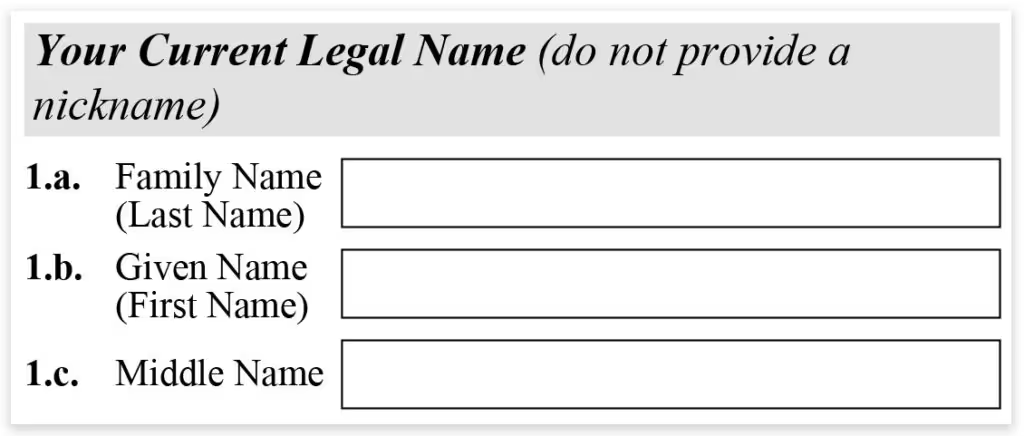
1.a. - 1.c. - Esta sección es sólo para pedir su nombre legal. Asegúrese de incluir su nombre legal completo. Si tienes dos apellidos, debe incluir ambos.

2.a. - 4.c. - Esta sección está pidiendo otros nombres que usted ha utilizado en su vida. Esto podría incluir su nombre, el nombre de soltero (a) con cónyuges anteriores, nombre familiar al nacer, apodos, alias o nombres supuestos.
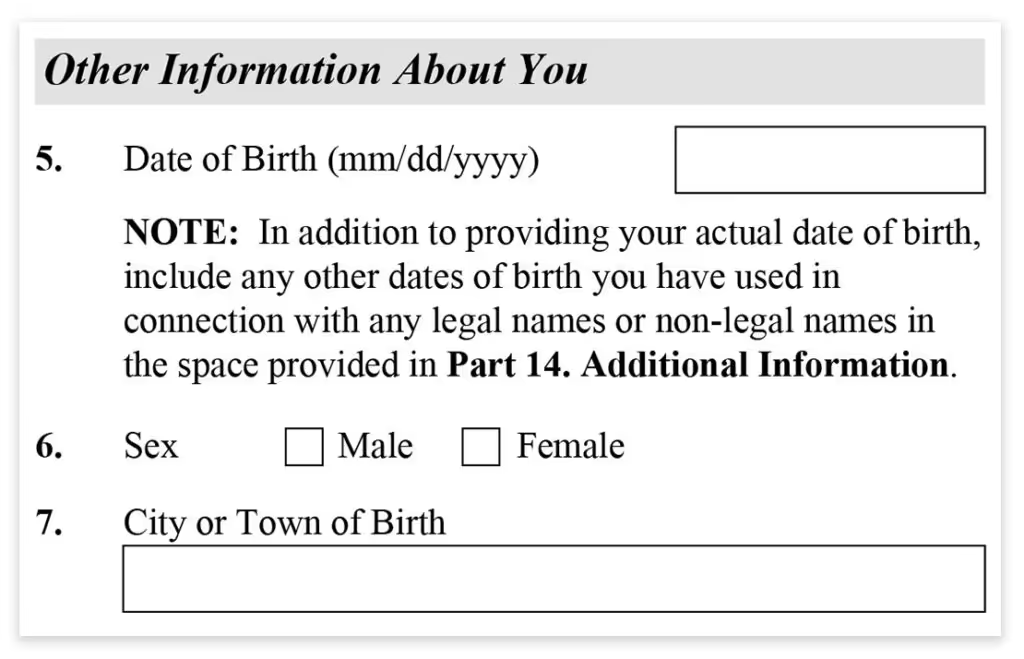
5. Esta es su fecha de nacimiento en el formato MM/DD/AA.
6. Su género.
7. Su lugar de nacimiento. No hay necesidad de incluir direcciones.
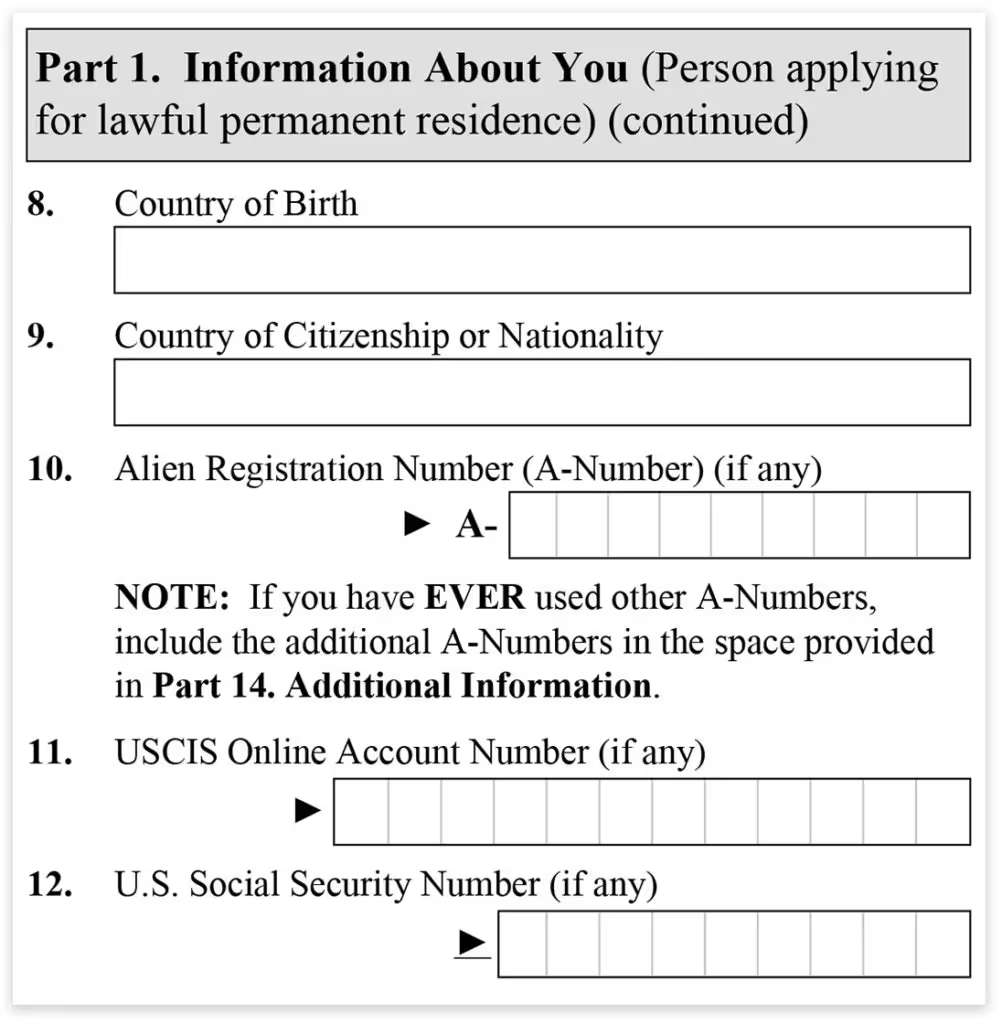
8. País de nacimiento.
9. País de nacionalidad o ciudadanía.
10. Este es su número de registro de extranjero, si usted tiene uno. Puede encontrar este número en su tarjeta de autorización de trabajo (EAD).
11. Este es su número de registro online de la USCIS. Usted tendrá solamente esto si has creado una cuenta en USCIS.gov
12. Número de seguro social de los EE.UU. si es que posee uno.
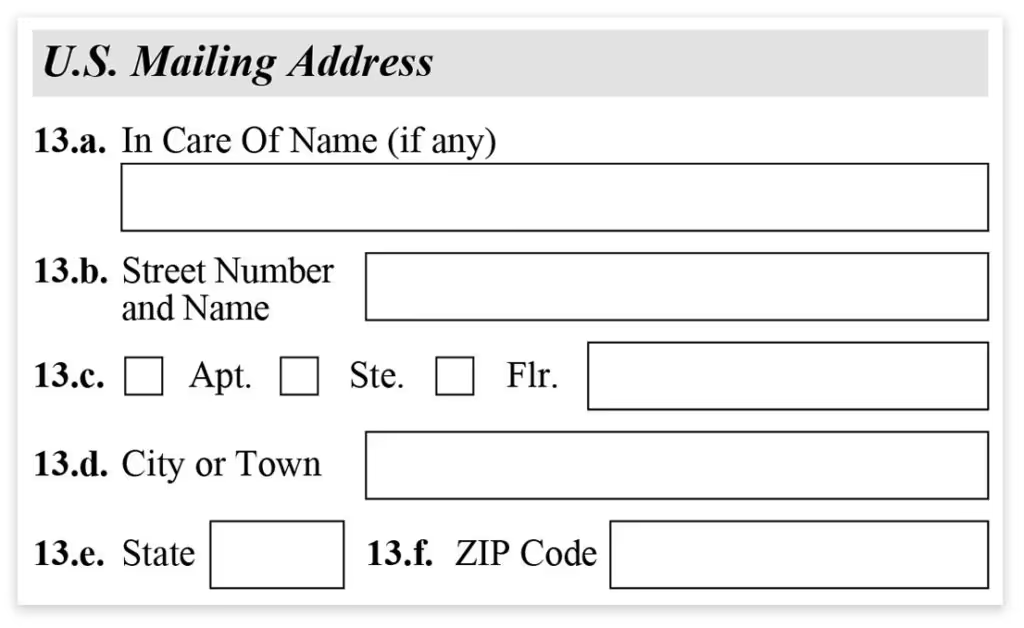
13.a. - 13.f. - Este es su actual dirección postal en los EE.UU. Si alguien está recibiendo el correo por usted, su nombre será incluido en la 13.a.
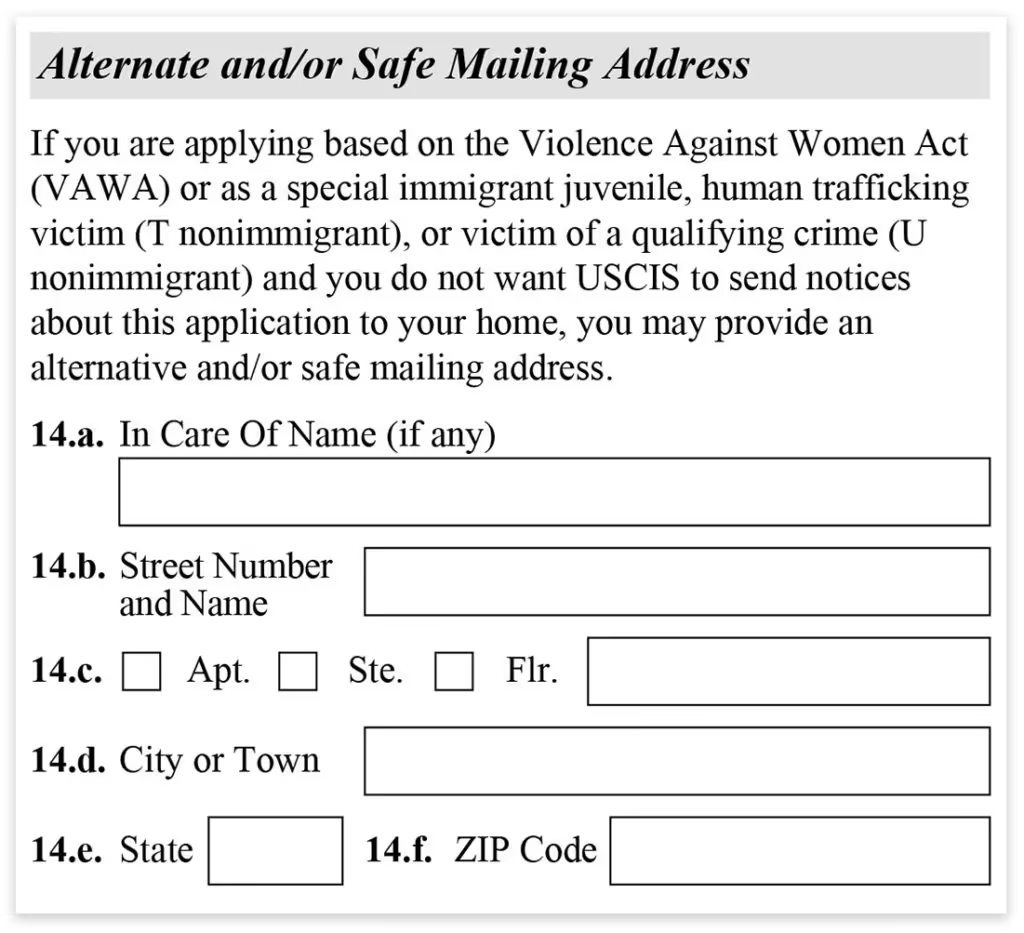
14.a. - 14.f. - Esta sección es para una dirección segura para los inmigrantes que soliciten su Green Card bajo el Acta de Violencia Contra la Mujer (VAWA), inmigrantes menores especiales, víctima de la trata de personas (no inmigrante T), o víctima de un delito de calificación (U-inmigrante). Usted debe rellenar esta sección si no desea que el USCIS envie avisos a su casa.
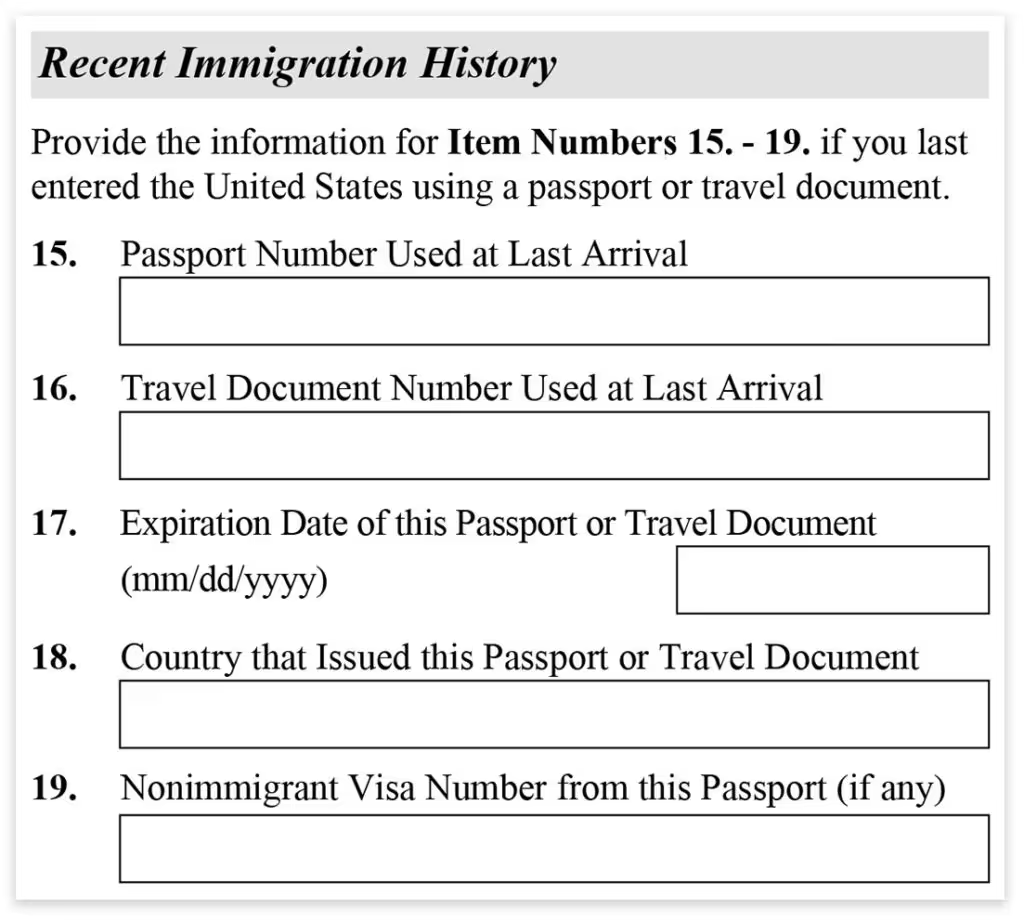
15 - 19 - Usted va a contestar estas preguntas si usted entró en los Estados Unidos con un pasaporte o documento de viaje.
15. Número de pasaporte.
16. Si ingresó con un permiso de viaje debe de incluirlo aquí.
17. Esta es la fecha de expiración de su pasaporte o documento de viaje.
18. País emisor del pasaporte o documento de viaje.
19. Si posee una visa de no-inmigrante en su pasaporte agréguela aquí.

20.a. - 20.b. Esta es la ciudad o pueblo donde entraron a Estados Unidos la última vez que voló hacia el país, será la ciudad con el aeropuerto dónde pasó por la Oficina de Aduanas y Protección Fronteriza. Por ejemplo, si había una parada o escala en los EE.UU. antes de llegar a su destino final, se habría sido a través del Servicio de Aduanas y Protección Fronteriza antes de su destino final. Si usted entró en el país por tierra o por mar, usted pondrá a la ciudad con el cruce de la frontera o la ciudad con la frontera más cercana donde haya llegado.
21. Fecha del último ingreso a los Estados Unidos.
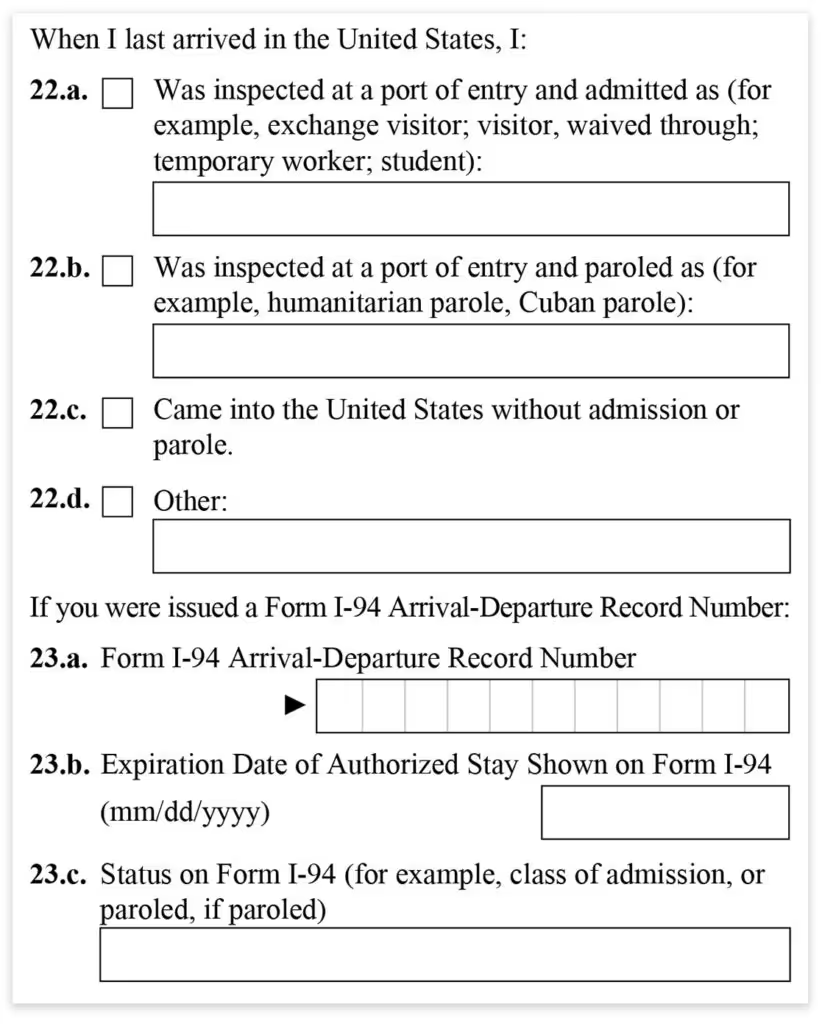
22.a. - 22.d. Aquí podrá verificar si fueron inspeccionado por un oficial de inmigración. De ser así significa que un oficial de inmigración ha estampado su pasaporte la última vez que se llegó a los EE.UU. si ha sido inspeccionado por un oficial también podrás poner tu estado de admitido como F-1 (de estudiante) o B-2 (visitante de placer). Si no conoce el código de designación de la visa, usted puede describir su estado con un término como el de "estudiante" o "visitante" o "asilado". También puedes encontrar el código en la visa EE.UU. en su pasaporte. Si su estado es "libertad condicional humanitaria" o la de "libertad condicional de Cuba", utilize 22.b. Si usted entró en el país sin permiso, usted utiliuzará 22.c. Si se tratara de cualquier otra circunstancia la 22.d. y explicar la circunstancia.
Si usted no recuerda ninguna de esta información, usted puede encontrar la mayoría de esta en su Formulario I-94 más reciente en el sitio web del Departamento de Seguridad del Territorio Nacional (DHS). A menos que usted llegara antes del 30 de abril de 2013, de ser así usted encontrará el formulario I-94 en su pasaporte.
23.a. Aquí debe de indicar el número de registro de llegada-salida I-94. Puede accesar al I-94 en el link anterior.
23.b. Aquí podrás poner el "admitir hasta la fecha encontrada" en tu I-94. Casi siempre esto es diferente a la visa de Estados Unidos en su pasaporte, así que asegúrese de poner la fecha de I-94. Bajo alguna condición, principalmente estudiantes y un programa de intercambio de visitantes, usted no tendrá ninguna fecha de caducidad exacta. En su lugar, el I-94 dirá "D/S" significa la duración del estado. Si tu I-94 dice "D/S", usted comprenderá que en lugar de una fecha de caducidad específica.
23.c. Aquí debe de ingresar el status indicado en su formulario I-94. Este puede ser su clase de admisión o de ingreso condicional de tener uno.
Si actualmente no tienen condición jurídica, debe indicarlo. Si I-94 ha expirado debe de poner "permanecencia pasado el plazo legal". Si usted entró sin permiso, debe poner "EWI" (entrada sin inspección). Si esta es su situación, no puede ser elegible para un ajuste de estatus si es pariente inmediato de un ciudadano estadounidense. Independientemente, es posible que desee buscar asesoría jurídica si esta es su situación.
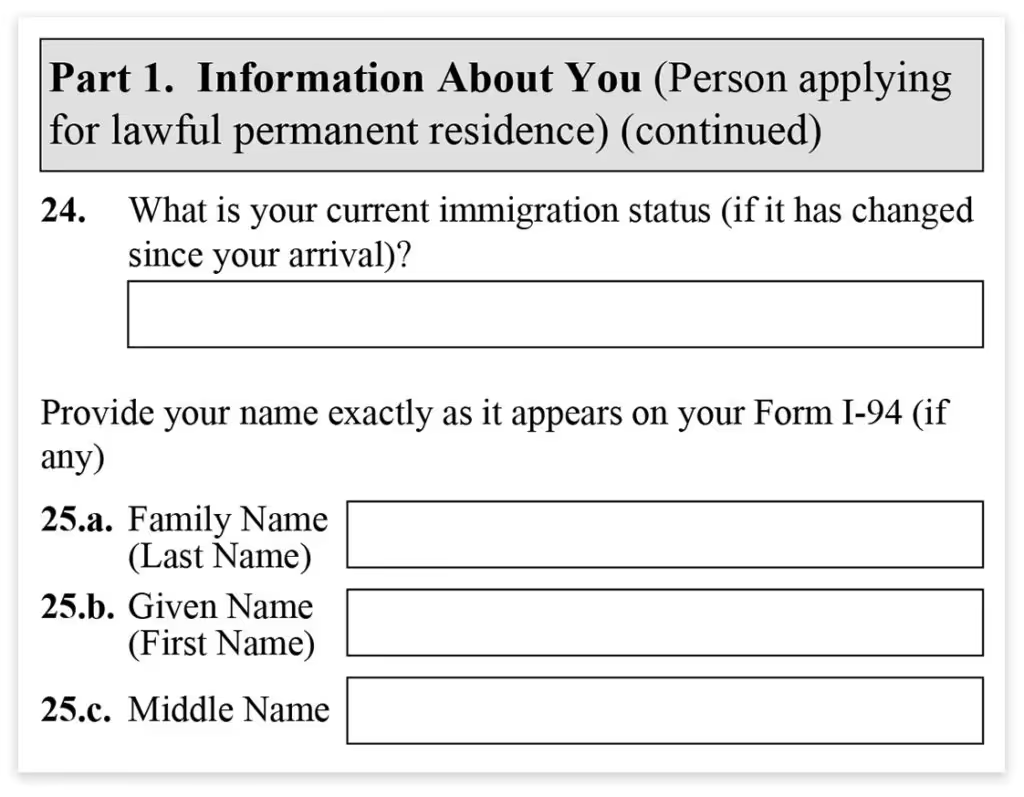
24. Si su estatus migratorio ha cambiado desde su llegada, es aquí donde debe de incluir su estatus migratorio actual.
25.a. - 25.c. Aquí debe de poner su nombre EXACTAMENTE a como se encuEntra en su I-94.
Parte 2. El tipo de aplicación o presentación de categoría.
Página 3
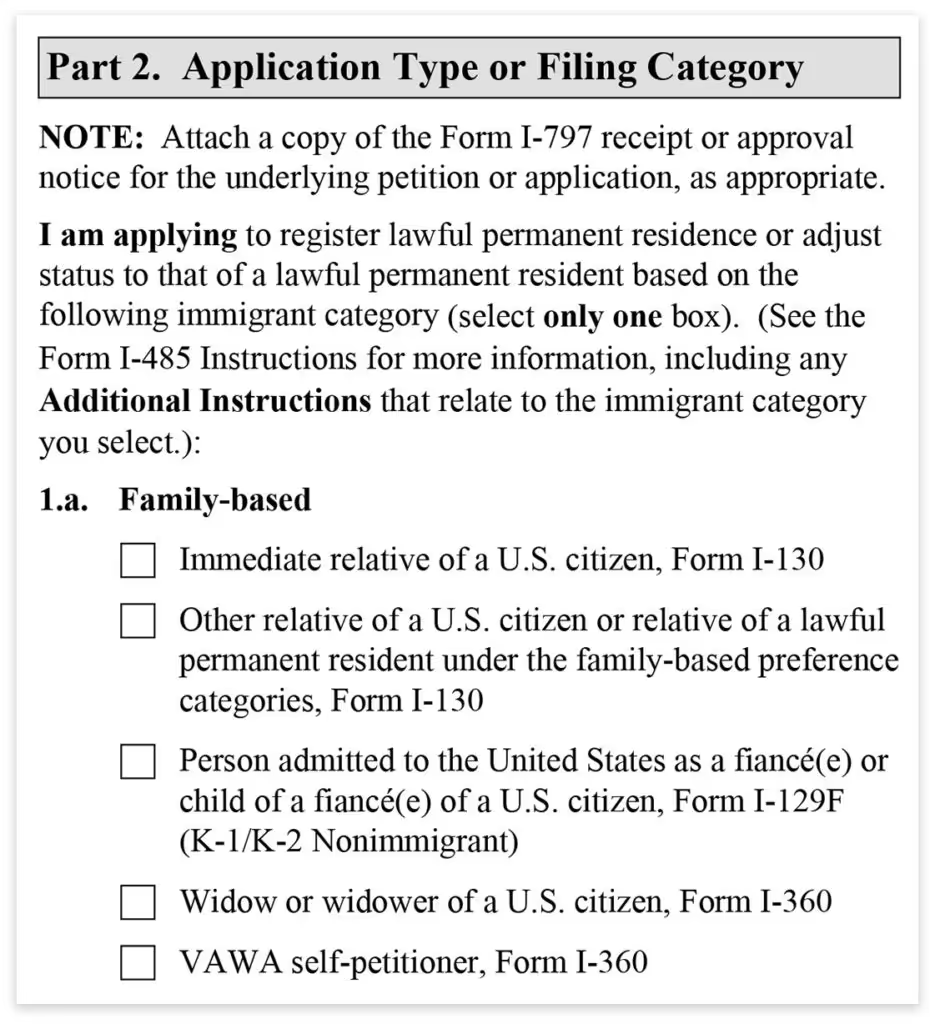
La parte 2 pide detalles sobre su elegibilidad para el ajuste de estatus. Si previamente le han aprobado un petición de inmigrante debe de incluir el recibo del Formulario I-797 o el aviso de aprobación junto con el formulario I-485.
1.a. - 1.g. Aquí hay una lista de las distitntas categorias de elegibilidad. Seleccione una que aplique para usted.

2. Probablemente esto no se aplique a usted. La Ley de Inmigración y Nacionalidad (INA) de la sección 245(i); es una antigua ley que se aplica solamente a un grupo selecto de personas que entraron en el país sin permiso. Para averiguar si esto se aplica a usted, visite USCIS.gov.
Información acerca de su categoría de inmigrante.
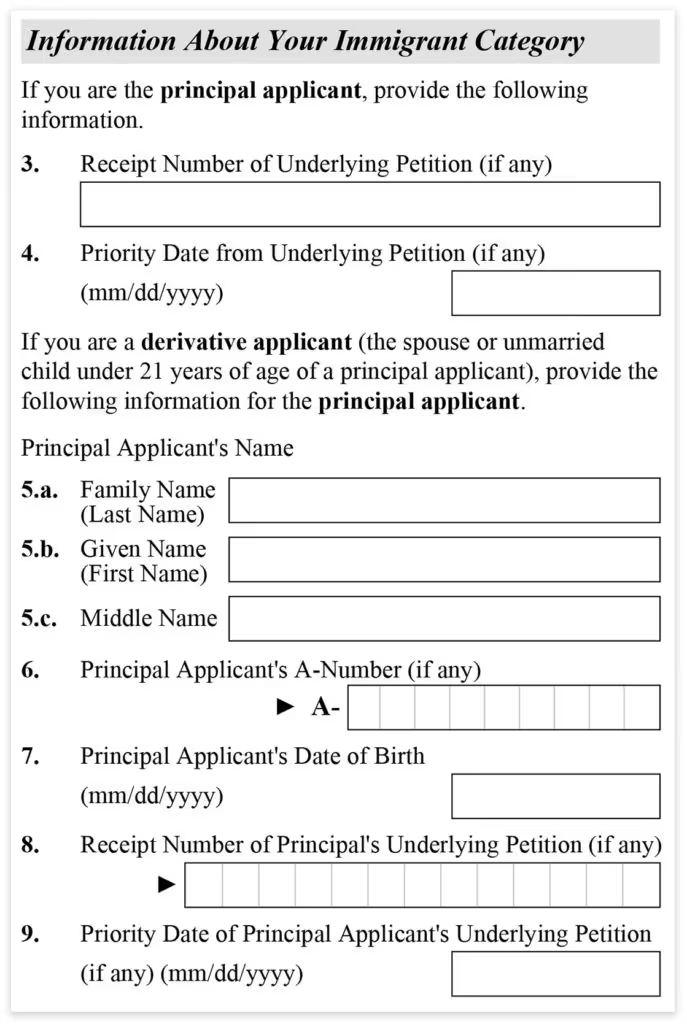
3. Si usted tiene una petición aprobada, usted debe incluir su número de recibo aquí. Una petición puede ser un formulario I-130, el formulario I-140, el formulario I-360, el formulario I-526 o I-918. El número de recepción será incluido en el Formulario I-797 en el aviso de aprobación que El USCIS le enviará por correo electrónico.
Si usted está presentando simultáneamente (es decir, rellenar la petición al mismo tiempo como el I-485), la pregunta 3 y 4 no se aplican a usted. Déjelo en blanco.
4. Si usted tiene una petición aprobada, usted debe incluir su fecha de prioridad aquí.
5 - 9. Esta sección sólo se aplica a un derivado del solicitante. Un derivado del solicitante es un inmigrante que no necesita una petición separada, en lugar de eso depende de la petición del solicitante principal. Probablemente este sea uno de los padres o cónyuge. En esta sección, se incluirá la información del solicitante principal.
Parte 3. Información adicional acerca de usted
Página 4
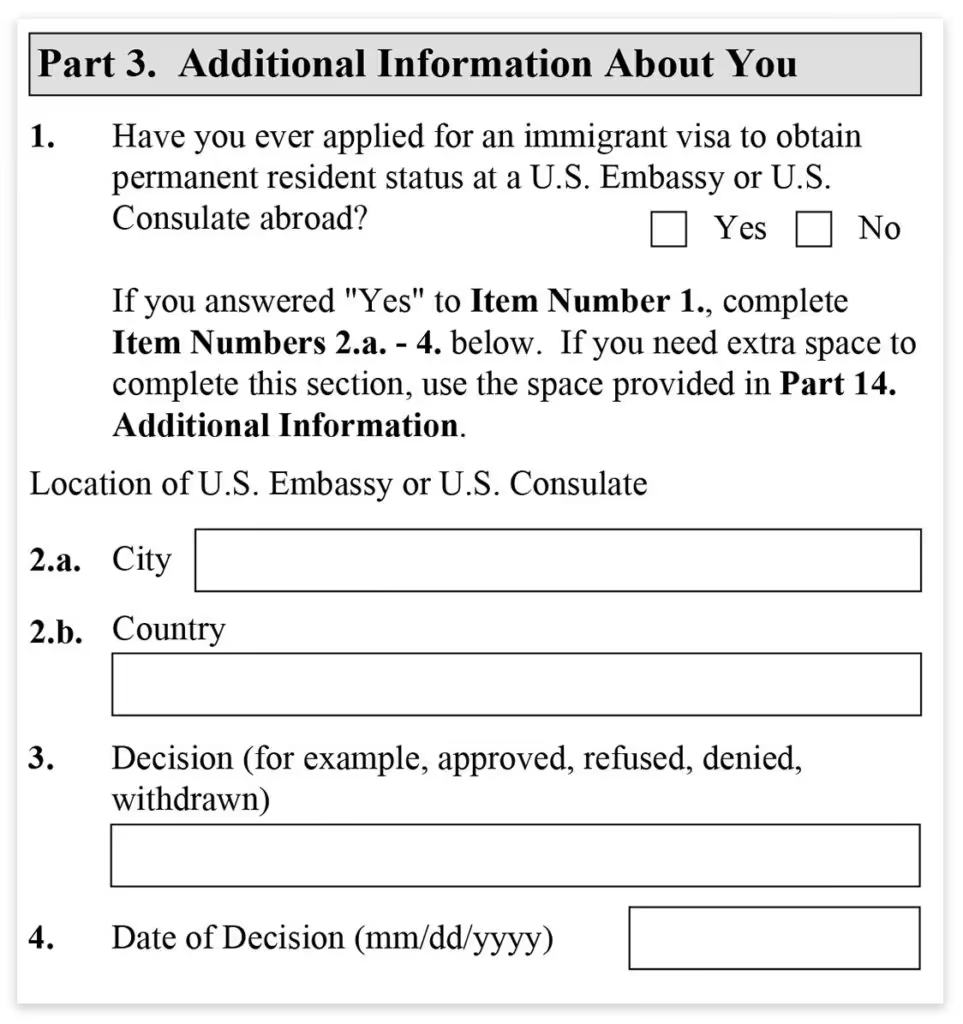
1 - 4. Si has solicitado una visa de inmigrante (Green card) en una embajada o consulado de EE.UU, tendrá que rellenar esta sección. En la pregunta 3 puede escribir: aprobado, rechazado, negado o retirado. No se preocupe por explicar por qué se tomó la decisión. No es necesario.

5 - 7. Aquí podrá proporcionar su dirección física historia durante los últimos cinco años. Proporcionar su dirección actual en primer lugar. Si usted ha tenido más de dos direcciones, puede incluir información adicional en la parte 14. Información adicional. Esta información se proporciona para el USCIS puede realizar una comprobación de antecedentes, por lo tanto, asegúrese de que es tan exacta como sea posible.
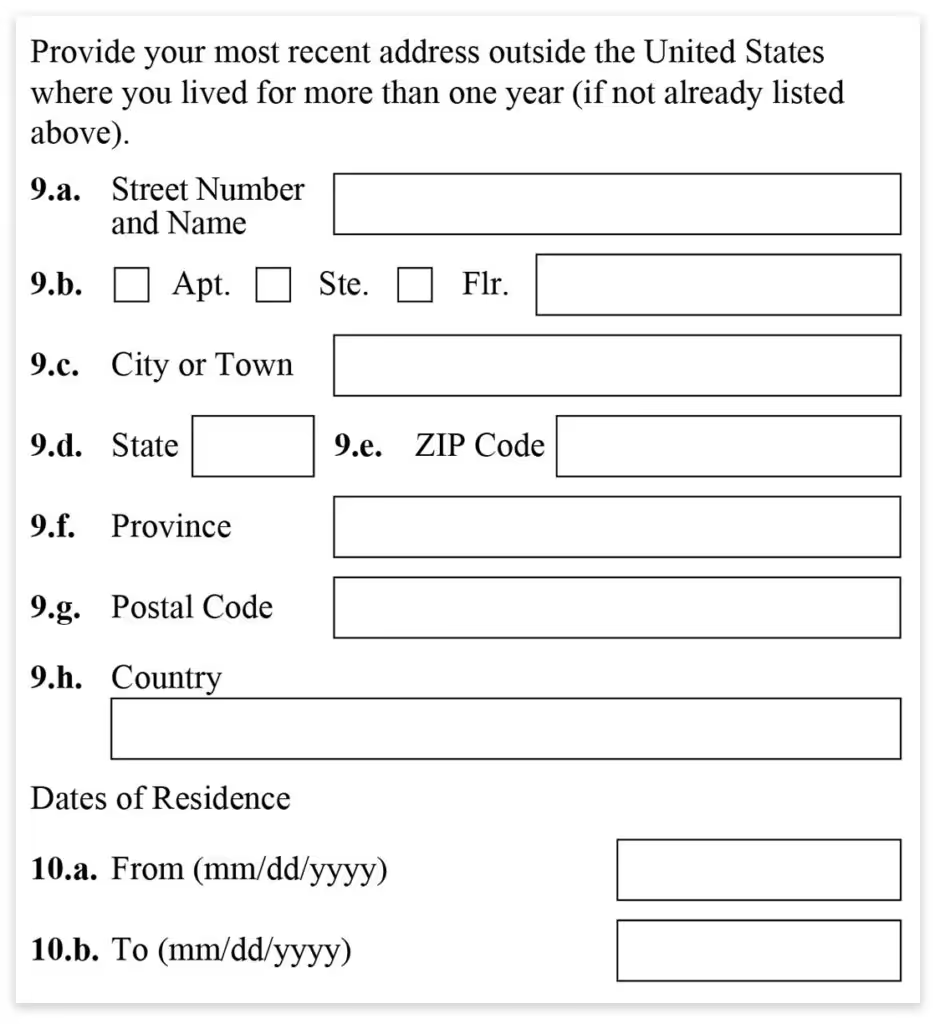
9.a. - 10.b. Aquí usted debe proporcionar su dirección más reciente fuera de los EE.UU. donde vive desde hace más de un año. Sin embargo, si ya ha proporcionado anteriormente, no es necesario incluirlo aquí.
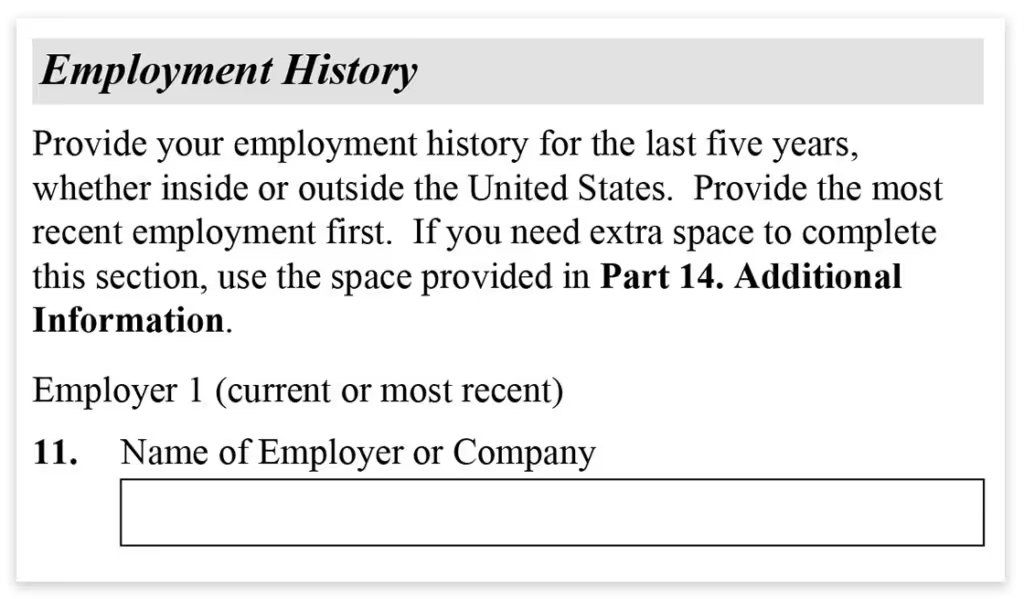
11 - 18.b. - Esto es también para un chequeo de antecedentes de la USCIS. Debe proporcionar a los 5 años de historial de empleo. Una vez más, asegúrese de que es tan exacta como sea posible. Si usted tiene información adicional, puede proporcionarla en la parte 14. Información adicional. Si usted no ha estado trabajando, escriba "Ninguno" o "N/A".
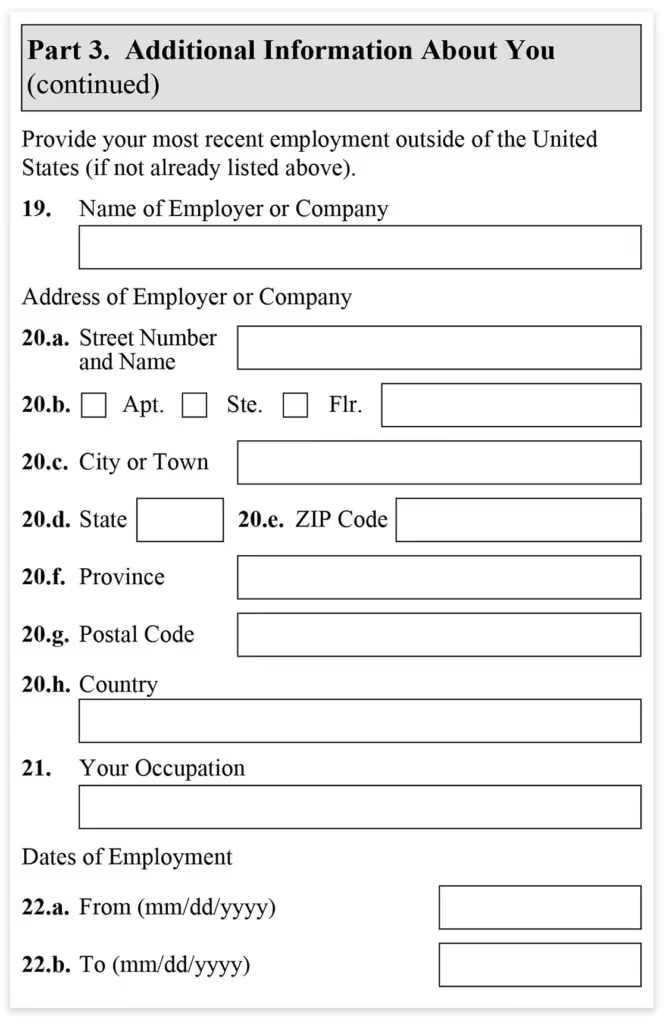
19 - 22.b. Aquí usted debe proporcionar su empleo más reciente (incluso si estuviera allí menos de un año) fuera de los EE.UU. si usted no ha proporcionado hágalo en 11-18.
Parte 4. Información acerca de sus padres
Página 6

En la parte 4 se solicita información básica acerca de sus padres. Si han fallecido, usted debe contestar fallecido en 7,8,15 y 16.
Parte 5. Información acerca de su historial matrimonial.
Página 7
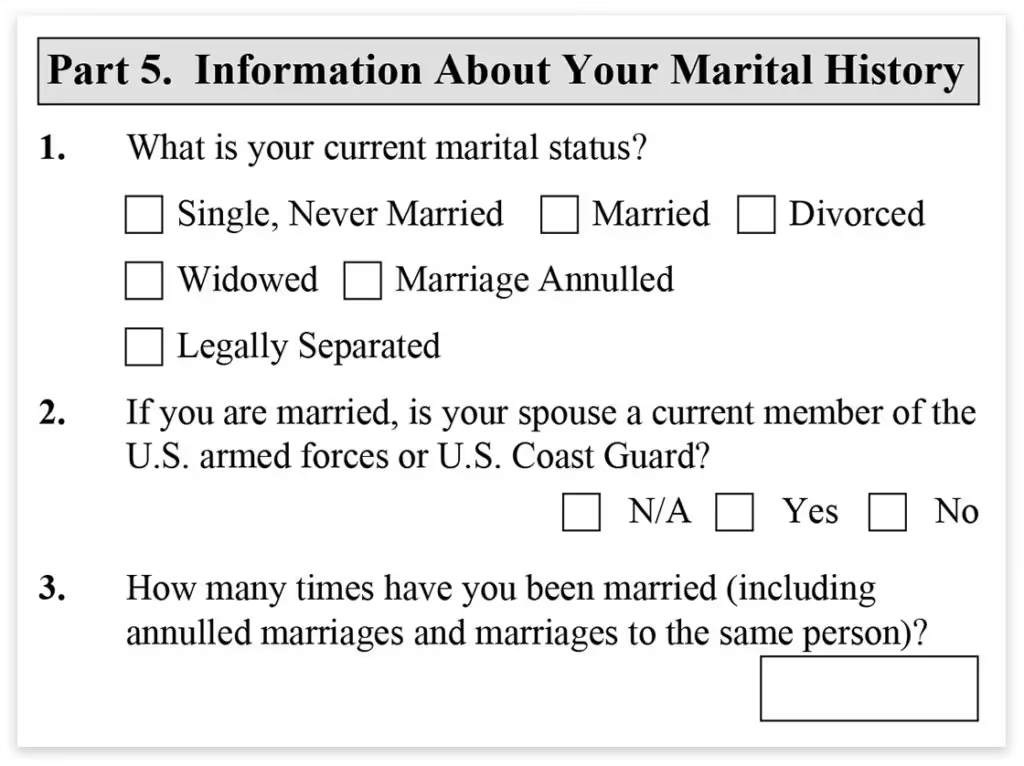
1 - 16.c. La parte 5 recopila información sobre su historial matrimonial. Esta sección es particularmente importante para aquellos solicitantes que inmigran a través del matrimonio. El USCIS quiere verificar que realmente son elegibles.
Se proporcionará información acerca de matrimonios anteriores. Si se queda sin espacio, una vez más, utilice la parte 14.
Parte 6. Información acerca de sus hijos(as).
Página 8
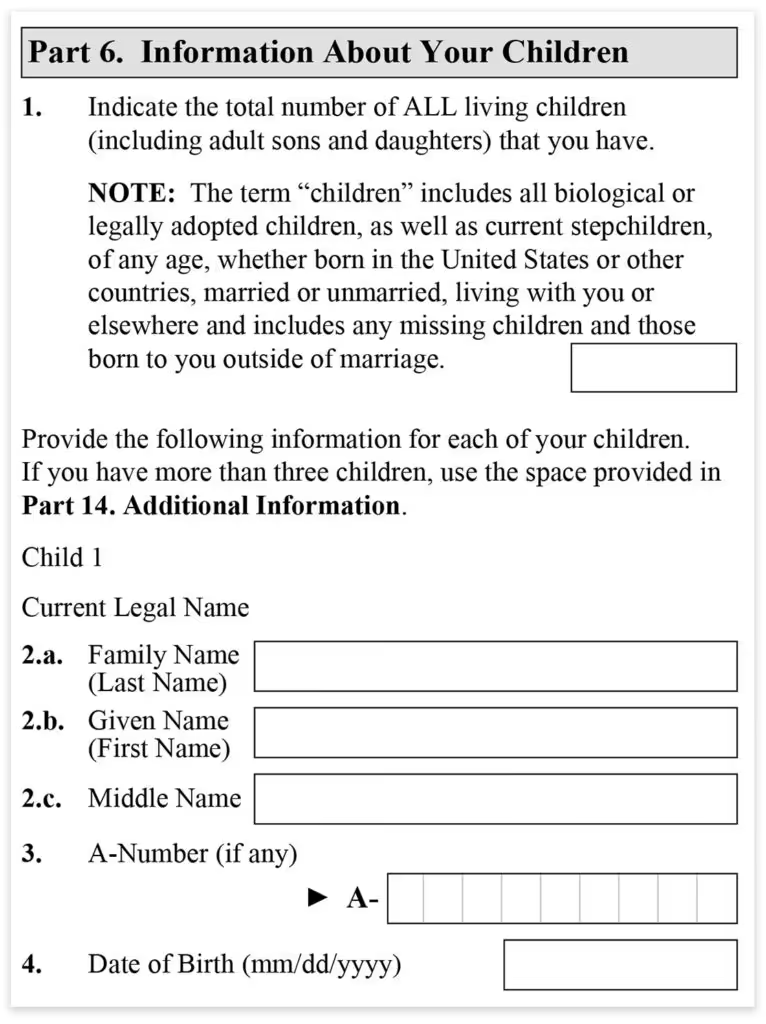
La parte 6 es donde puede proporcionar información acerca de sus hijos. En primer lugar, se indicará el número total de hijos vivos. Entonces usted podrá proporcionar información básica sobre ellos. Usted debe incluir tanto a los niños y los hijastros adultos aquí. Al no hacerlo podría crear dudas sobre su relación si quieren inmigrar a los Estados Unidos en el futuro. Si necesita más espacio, vaya a la Parte 14. Información adicional.
Parte 7. Información biográfica.
Página 8
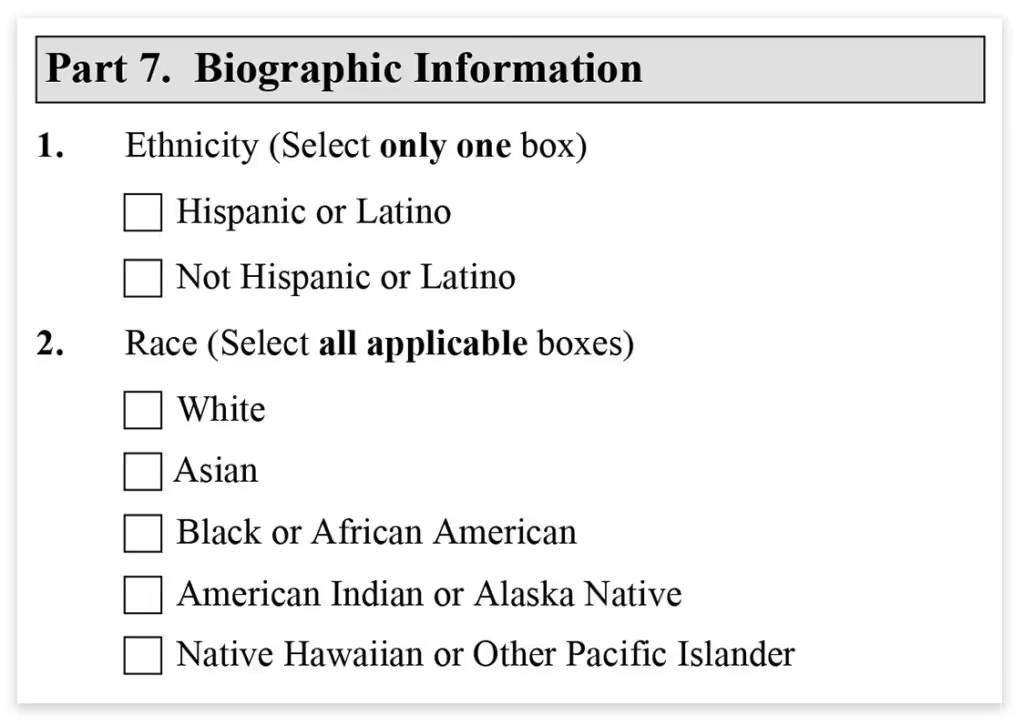
1. En esta sección, va a agregar algunos datos biográficos. Esto es así para que el USCIS pueda confirmar su identidad. Primero usted colocará si son o no hispanos. Hispano o latino es una persona de orígenes cubanos, mexicanos, puertorriqueños, Centro o Sudaméricanos, u otra cultura española.
2. En esta pregunta, usted pondrá su raza. Esto puede ser confuso porque hay sólo unas pocas categorías. Aquí hay una guía para el USCIS:
- Blanco es una persona con orígenes en cualquiera de los pueblos originales de Europa, Oriente Medio y África del Norte.
- El asiático es una persona con orígenes en cualquiera de los pueblos originales del Lejano Oriente, el sudeste de Asia o el subcontinente indio, incluyendo, por ejemplo, Camboya, China, India, Japón, Corea, Malasia, Pakistán, las Islas Filipinas, Tailandia y Vietnam.
- Negro o africano americano es una persona con orígenes en cualquiera de los grupos raciales negros de África.
- Los Indios americanos o nativos de Alaska son personas con orígenes en cualquiera de los pueblos originales de Norte y Sudamérica (incluyendo America Central), y que mantiene la comunidad tribal o accesorio.
- Nativo de Hawai o de otra isla del Pacífico es una persona con orígenes en cualquiera de los pueblos originales de Hawai, Guam, Samoa u otras islas del Pacífico.
3 - 6. Para el resto de preguntas, usted pondrá su altura, peso, color de ojos y color de cabello.
Parte 8. Requisitos generales y causales de inadmisibilidad.
Página 9

Esta sección es larga, no se preocupe.. El propósito de esta sección es para asegurarse de que no ha hecho nada para ser considerado inadmisible a los EE.UU, ser inadmisible significa que no serían elegibles para ingresar a los EE.UU. debido a crímenes, violaciones de inmigración, o por otras razones. Si usted ha estado involucrado en cualquier organización que promueve la violencia, usted debe buscar el asesoramiento de un abogado.
1 - 13.b. En esta sección, podrá incluir cualquier organización, asociación, fondo, fundación, partido, club, sociedad, etc., en los que ha participado. Esto es principalmente para determinar si usted ha estado involucrado en una organización violenta, pero incluidos los voluntarios o las organizaciones religiosas pueden ayudar a mostrar el USCIS oficial que usted es una persona de bien moral.
14 - 80.b. La mayoría de estas respuestas deben ser "no". Sin embargo, tienes algunas "sí". Si ha expirado la visa, usted debe contestar "sí" a la pregunta 17. A continuación, puede explicar las circunstancias en la parte 14. Información adicional. Sobre la pregunta 24.a. -24.c. también puede responder sí y explicar las circunstancias en torno a la visa J-1 el requisito de dos años.
Usted también debe revelar todos los arrestos, incluso si fue un error o un delito menor, deben de ser incluidos. No tiene que incluir multas de buceo a menos que drogas o alcohol estuvieran involucrados o si fueron multados con más de 500 dólares. Si usted tiene cualquier detención, deberá adjuntar la documentación con el formulario I-485.
Si usted ha recibido asistencia pública, usted podría ser considerado inadmisible. Si esta es su situación, usted debe consultar con un abogado antes de enviar su formulario I-485.
Recuerde: nunca mienta en ningún formulario de inmigración. Si el USCIS descubre que usted ha mentido sobre un formulario, puede ser declarado inadmisible.
Parte 9. Alojamiento para Individuos con Discapacidades y/o impedimentos.
Página 14

La parte 9 le pregunta si tiene alguna discapacidad o impedimento que necesite de alojamiento para su entrevista. Esto podría ser un intérprete de lengua de signos. Usted debe explicar su necesidad en esta sección.
Parte 10. Declaración del solicitante.
Página 15
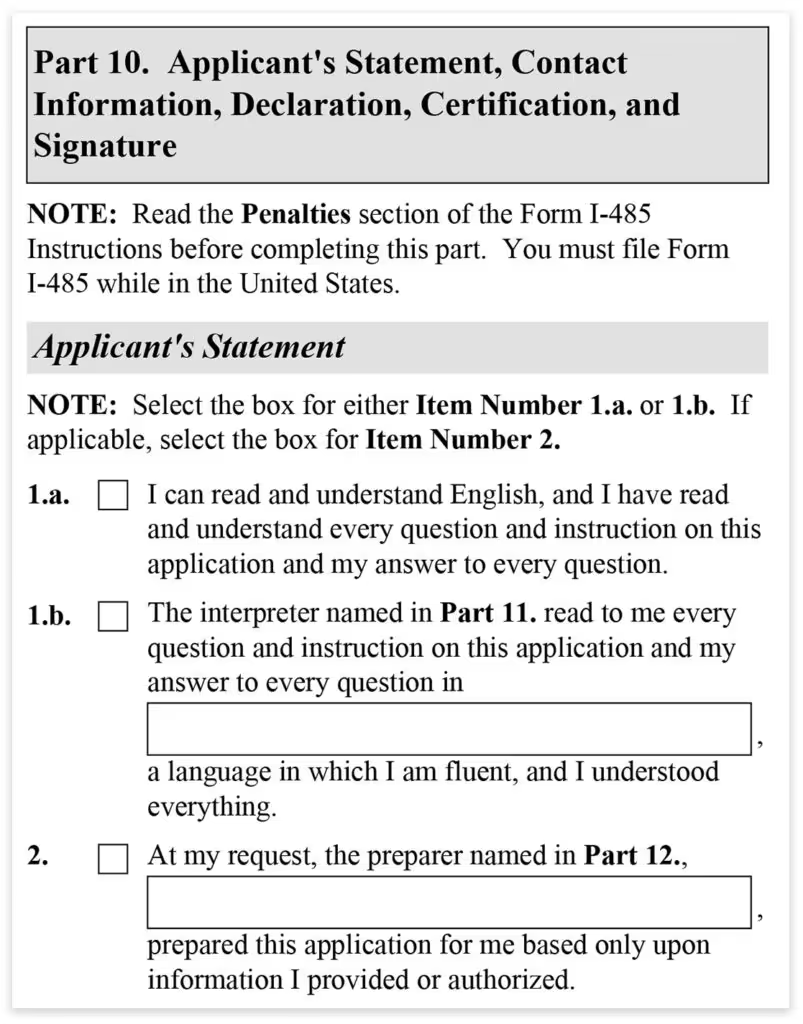
Felicidades, se acerca a completar el formulario! Aquí es donde debe firmar el formulario I-485. También podrá comprobar que puede leer y comprender el inglés, de modo que sepan entender lo que está firmando. También podrá incluir su información de contacto.
Parte 11. Información de contacto del intérprete, certificación y firma.
Página 15
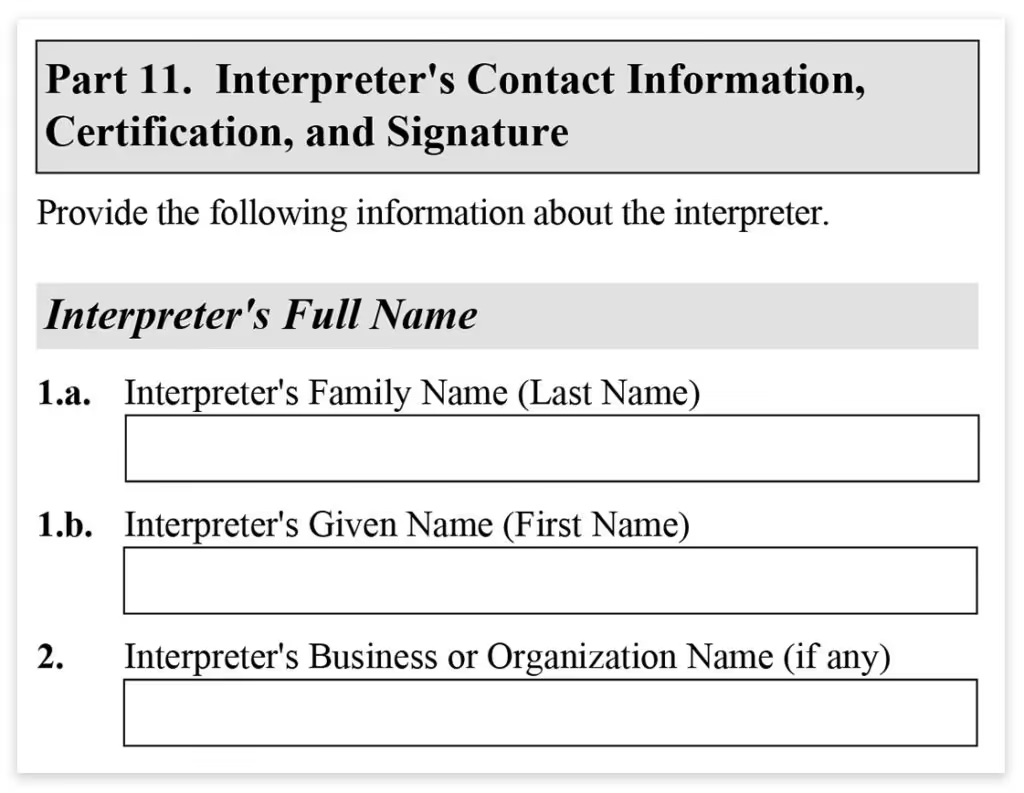
Si usted no habla inglés y ha utilizado un intérprete para rellenar el formulario I-485, este es el lugar donde él o ella va a firmar. Usted no necesita saber inglés para obtener una green card, pero necesitará un intérprete en su entrevista de la USCIS.
Parte 12. Información de contacto, certificación y firma.
Página 16
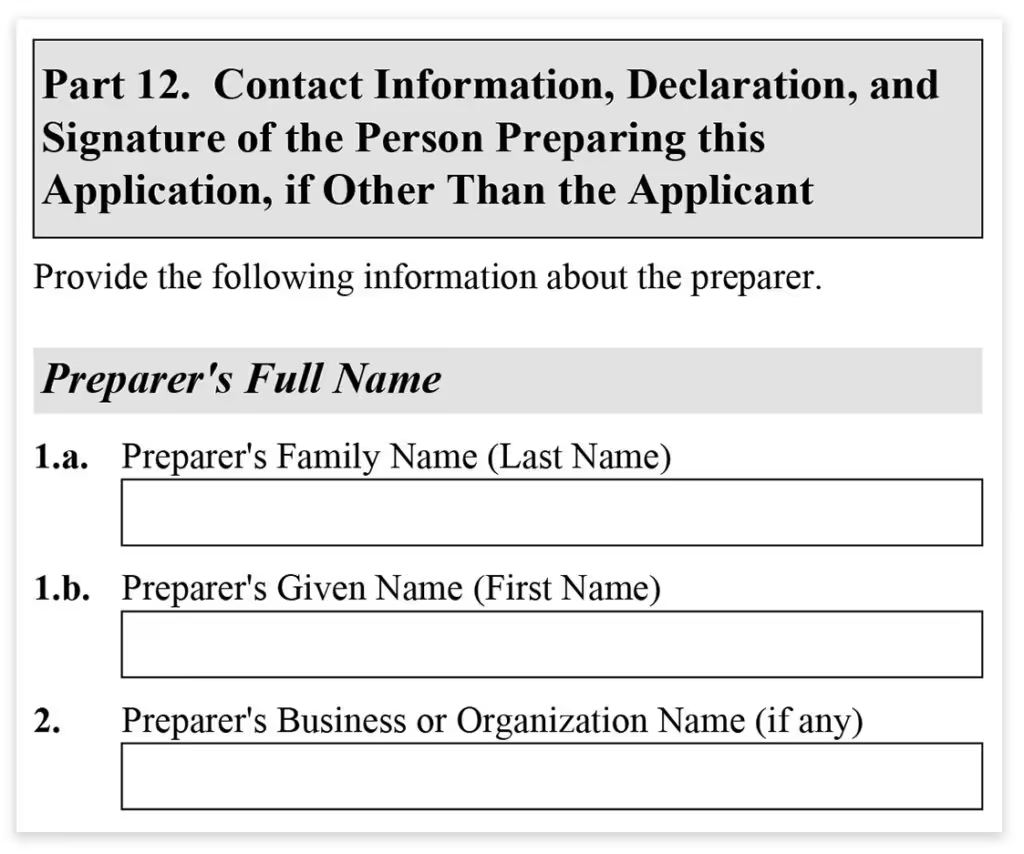
Aquí es donde un abogado incluiría sus credenciales. Probablemente usted deje esto en blanco, considerando que ha estado utilizando esta guía paso-a-paso.
Parte 13. Firma en la entrevista
Página 17
Esta es la sección quese firmará en su entrevista en el USCIS. Hasta su entrevista, déjelo en blanco. ¡Felicidades, has terminado!

